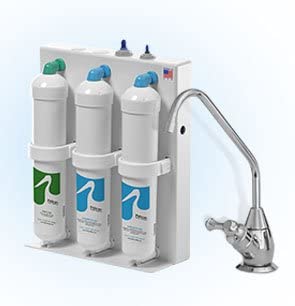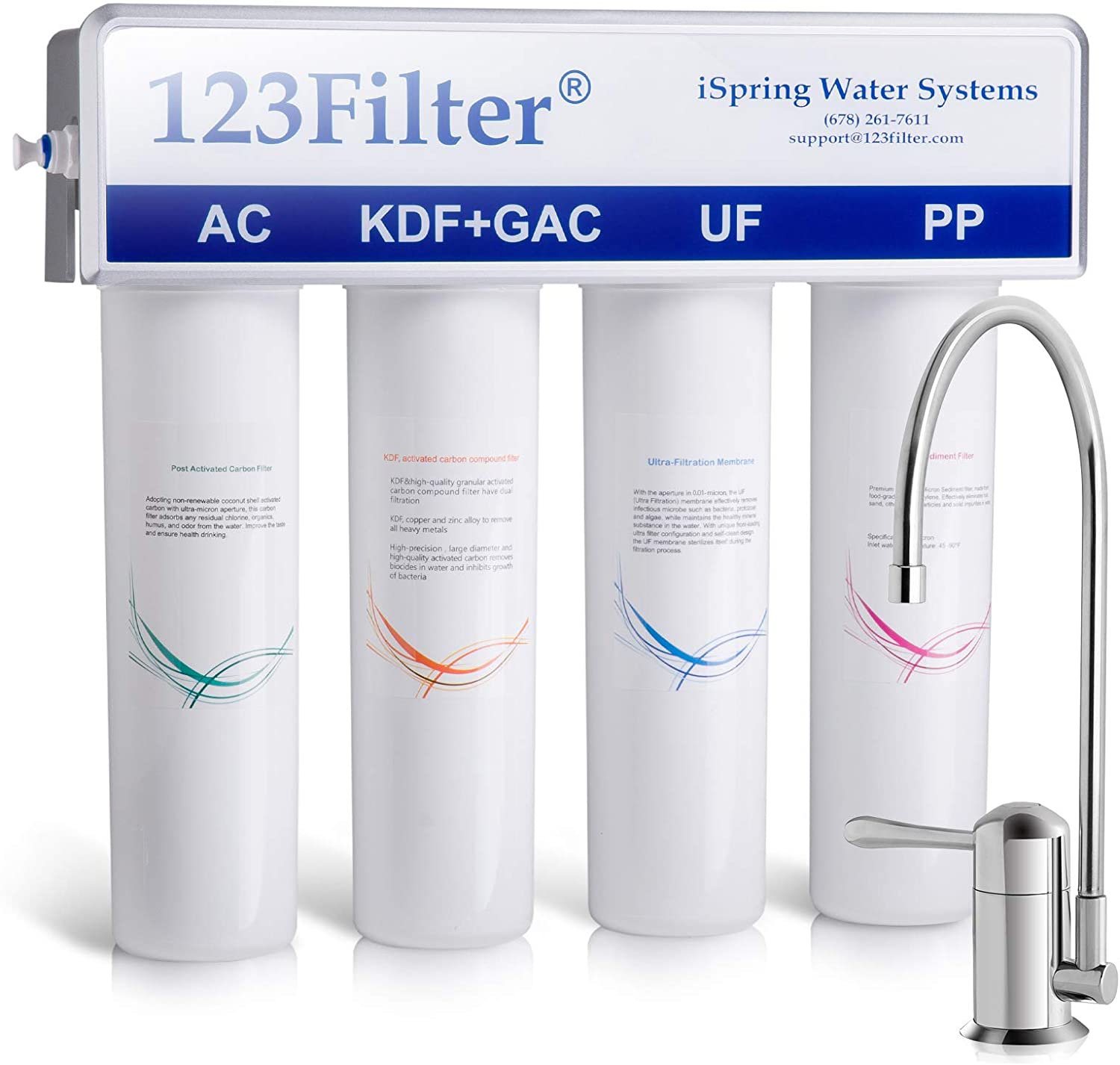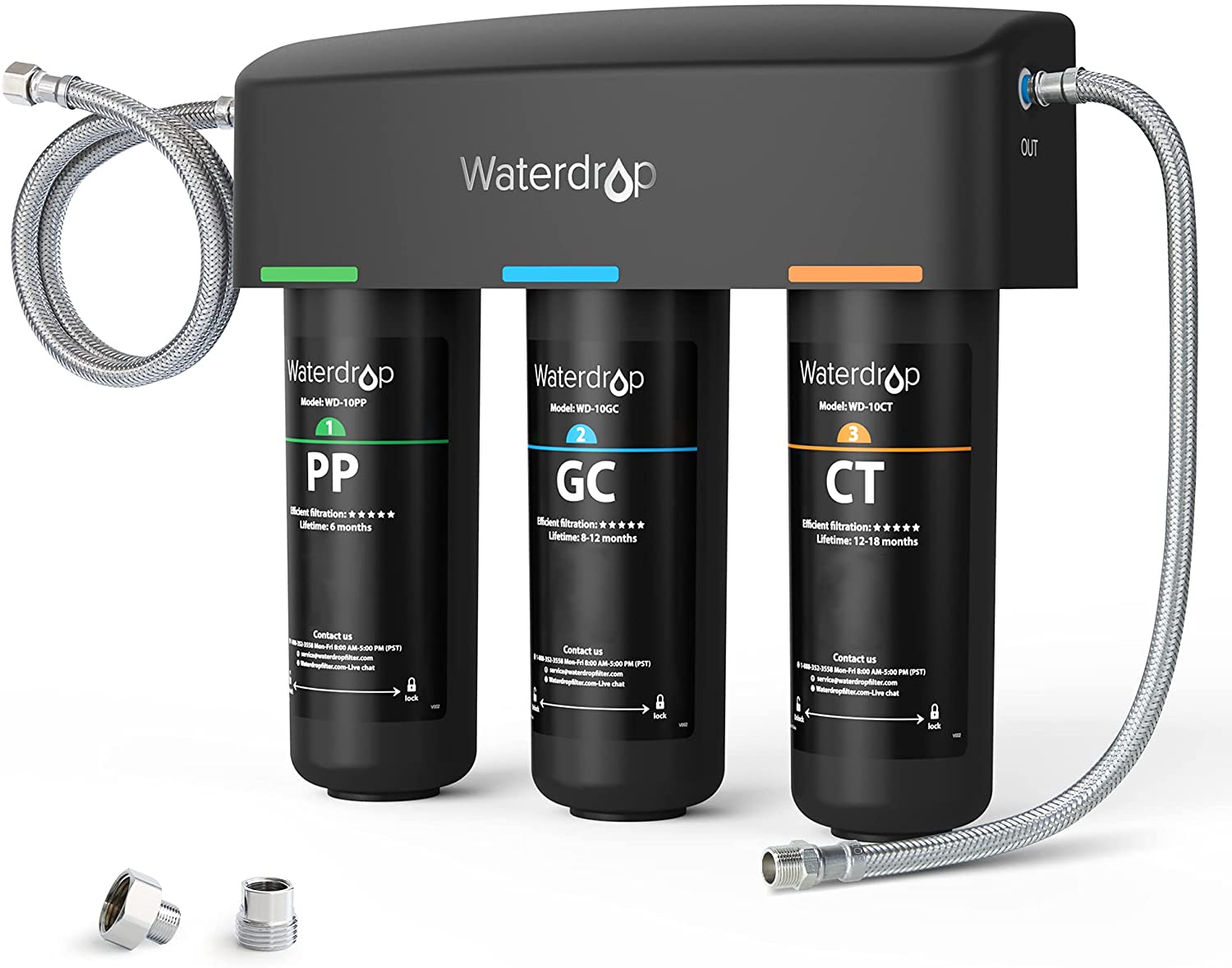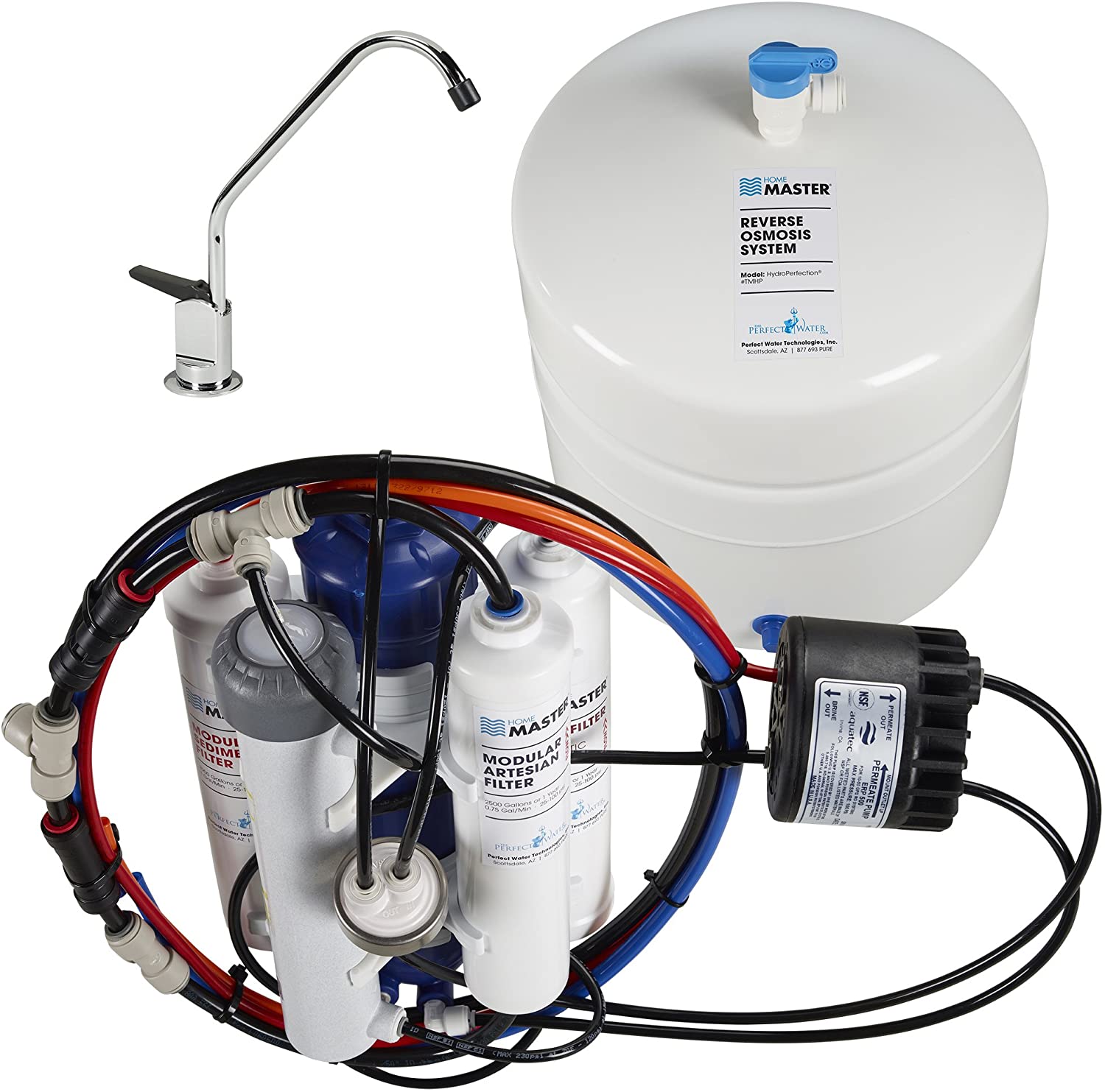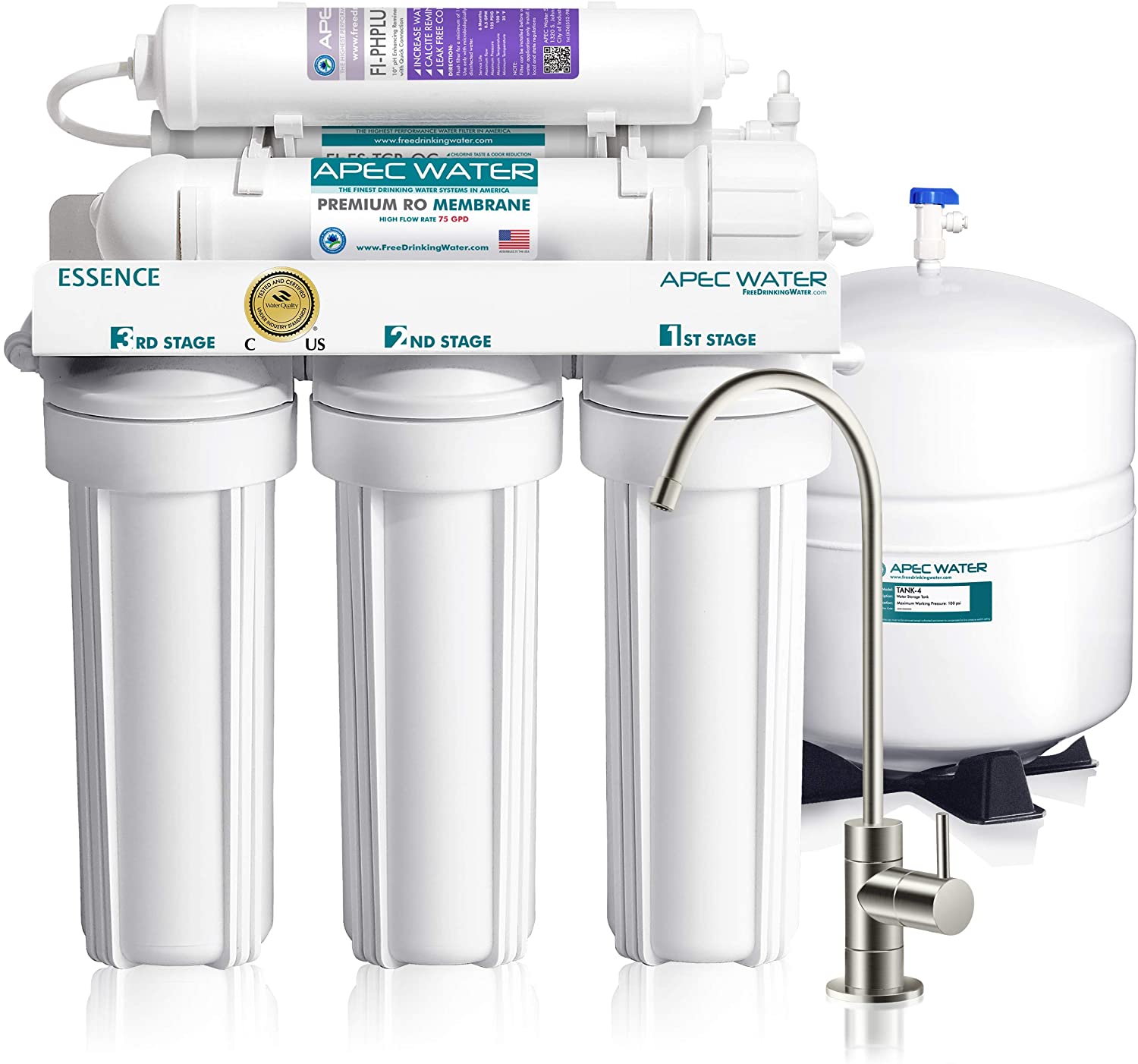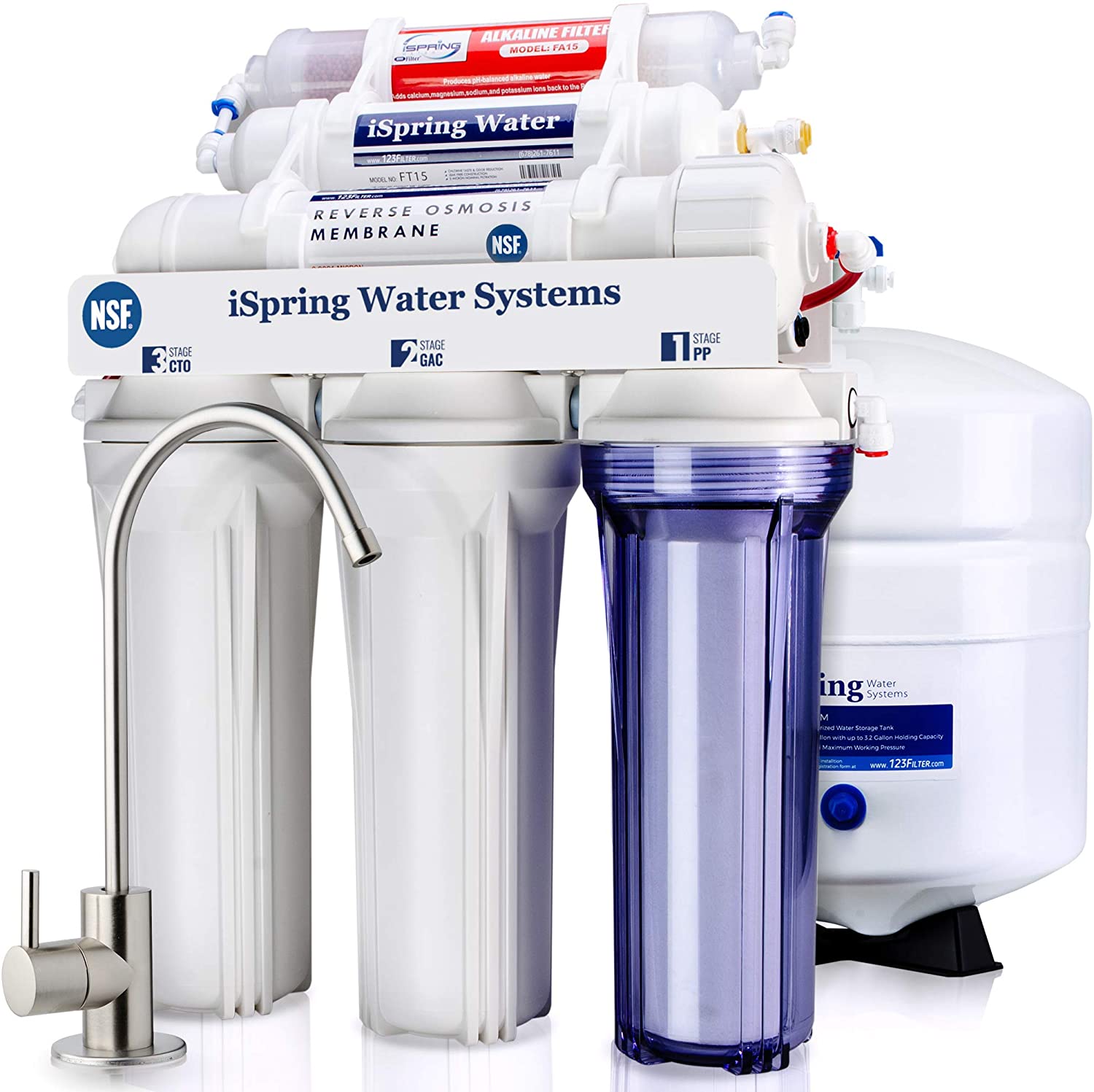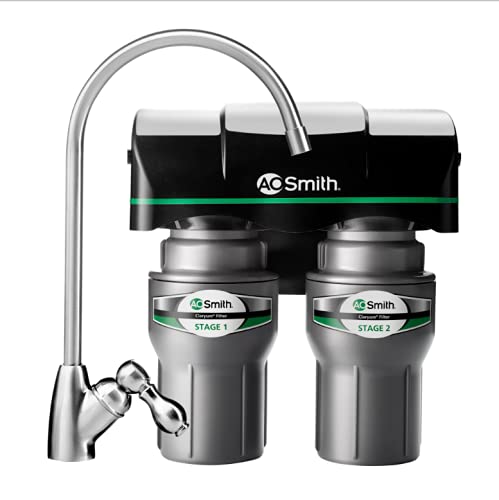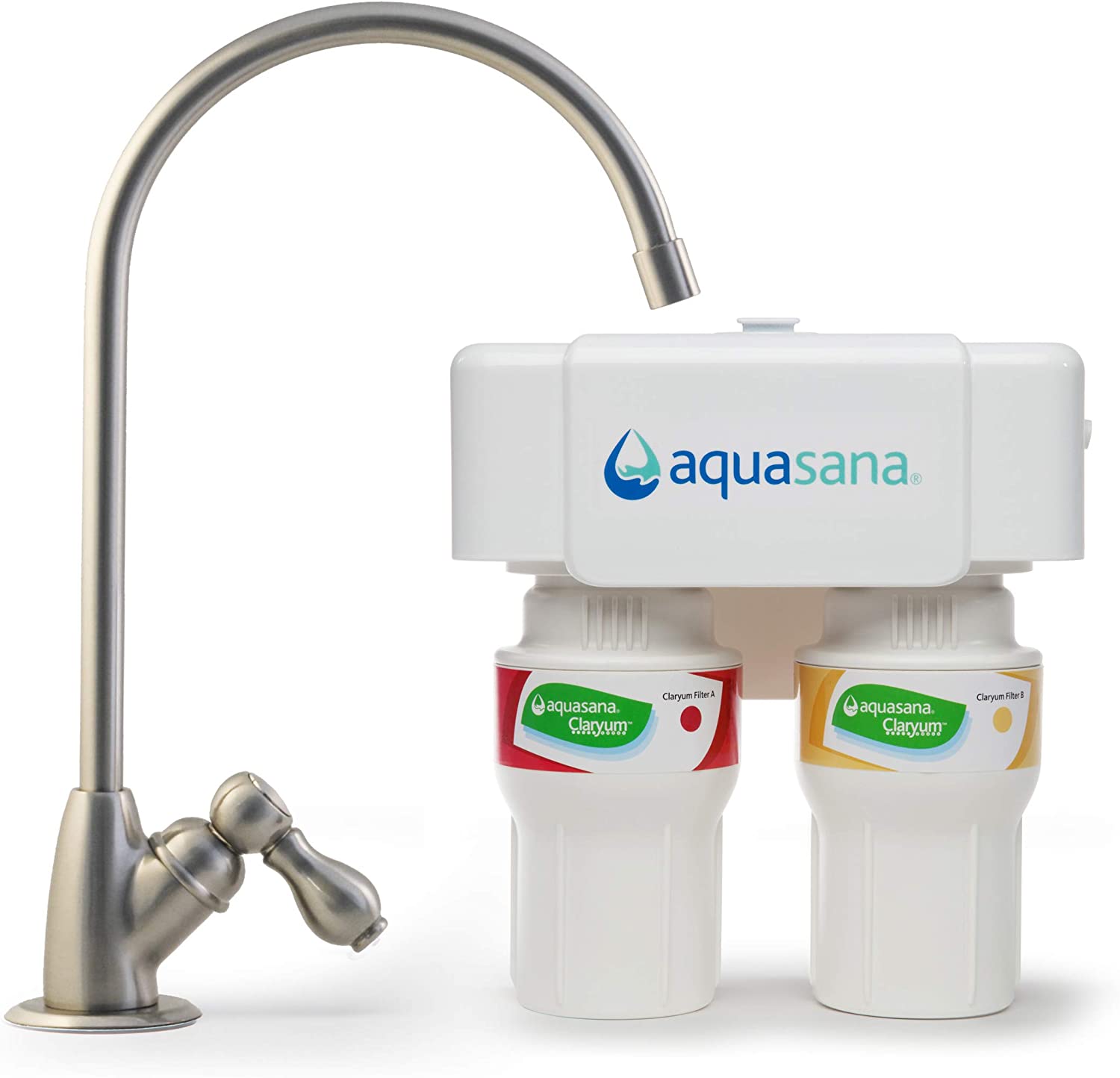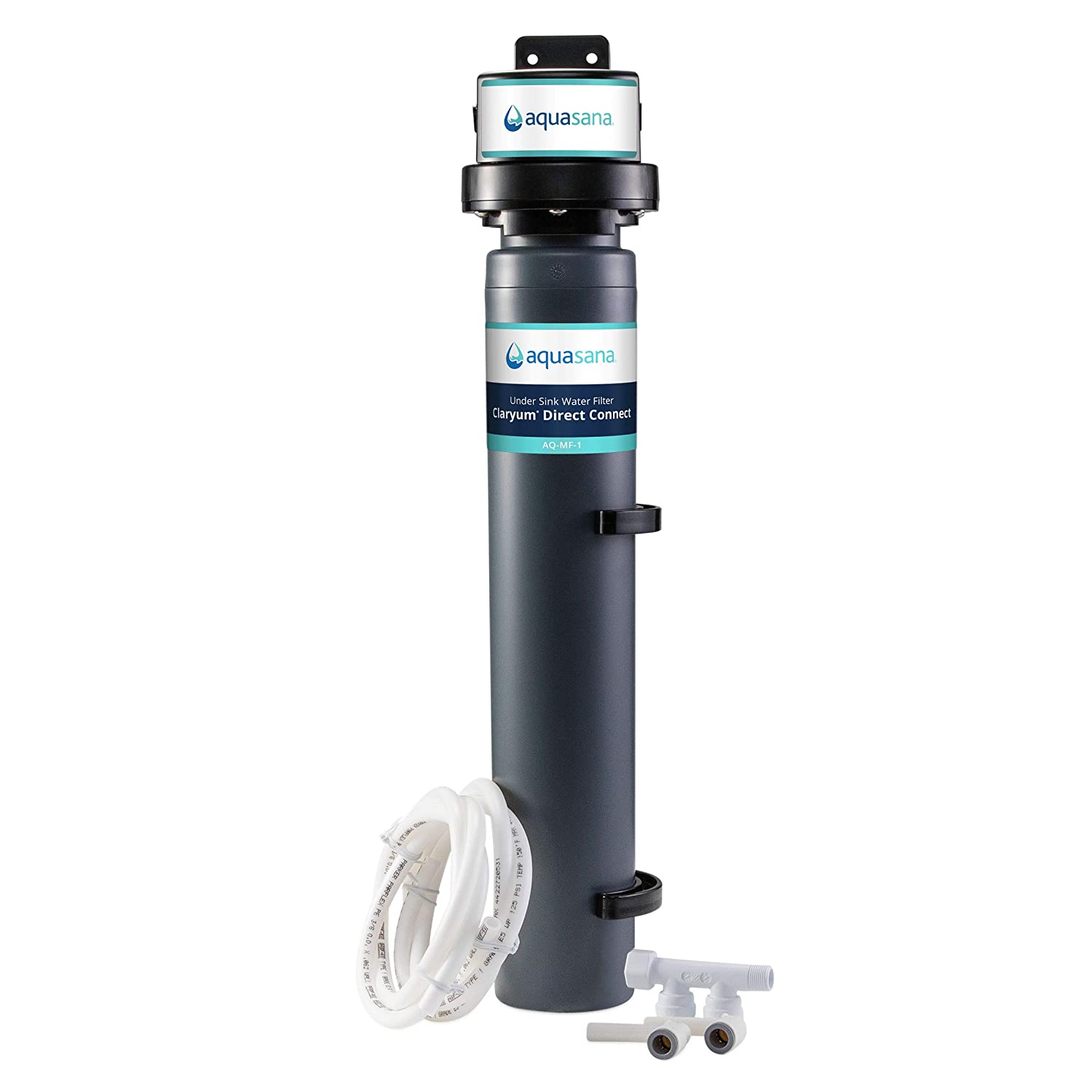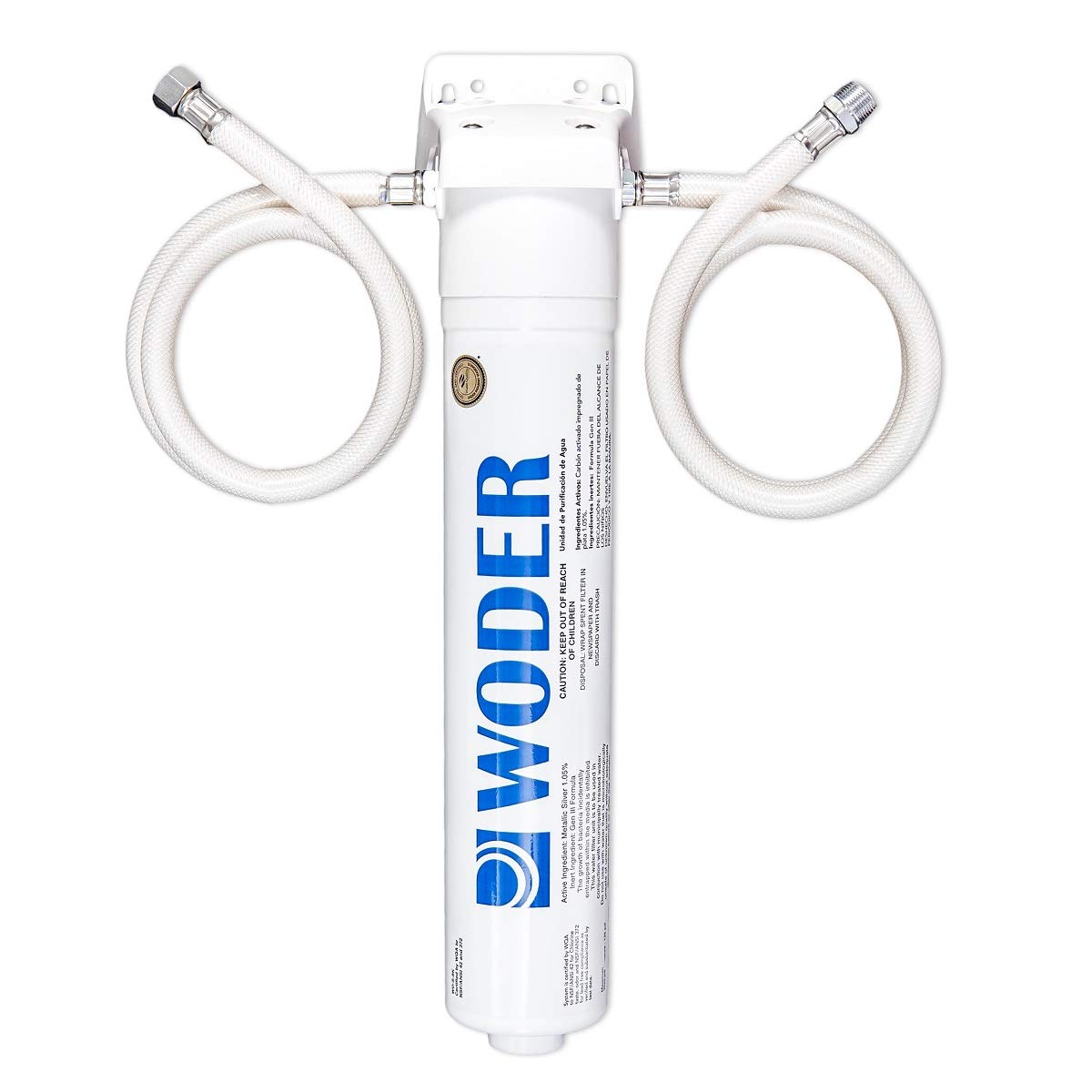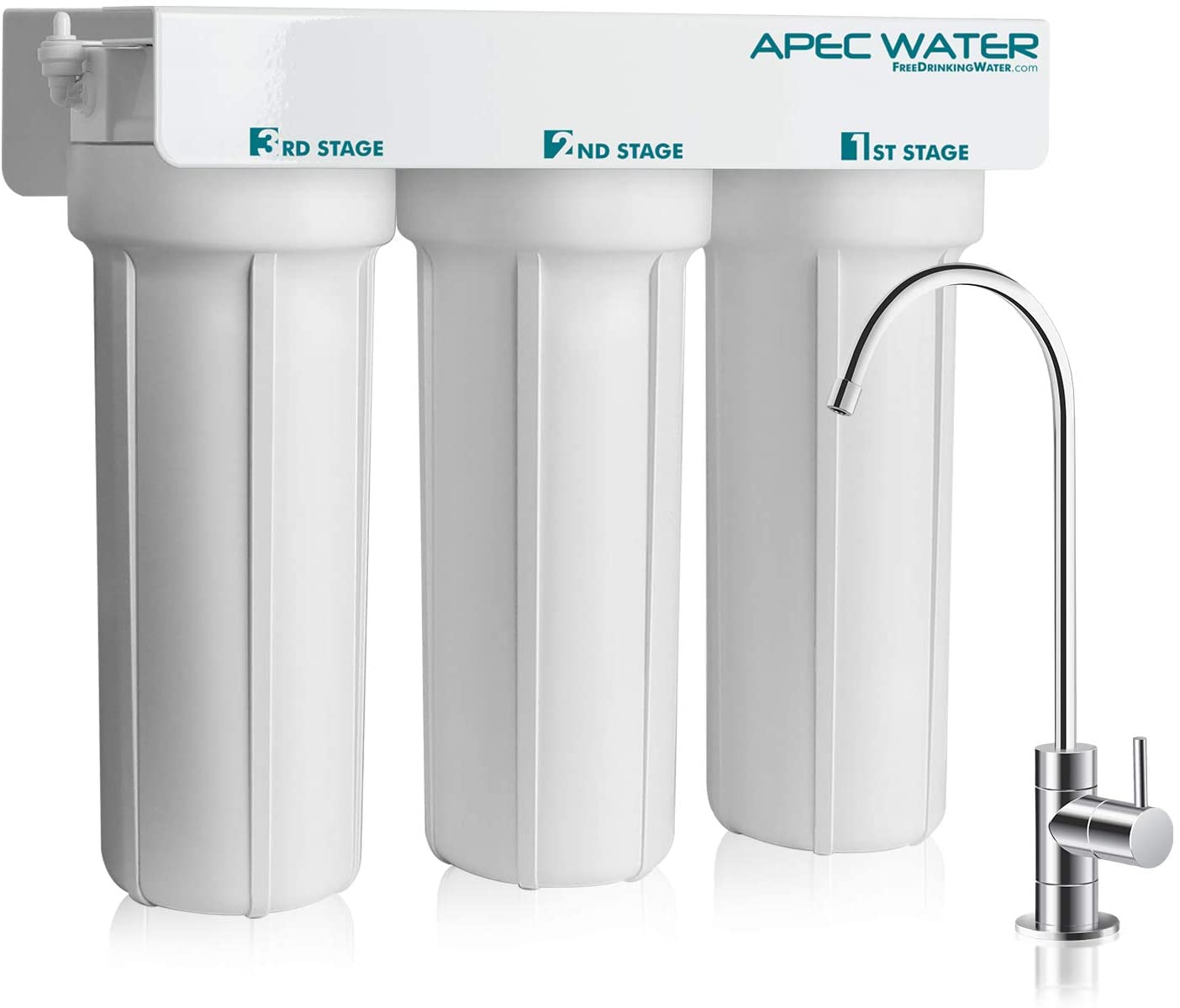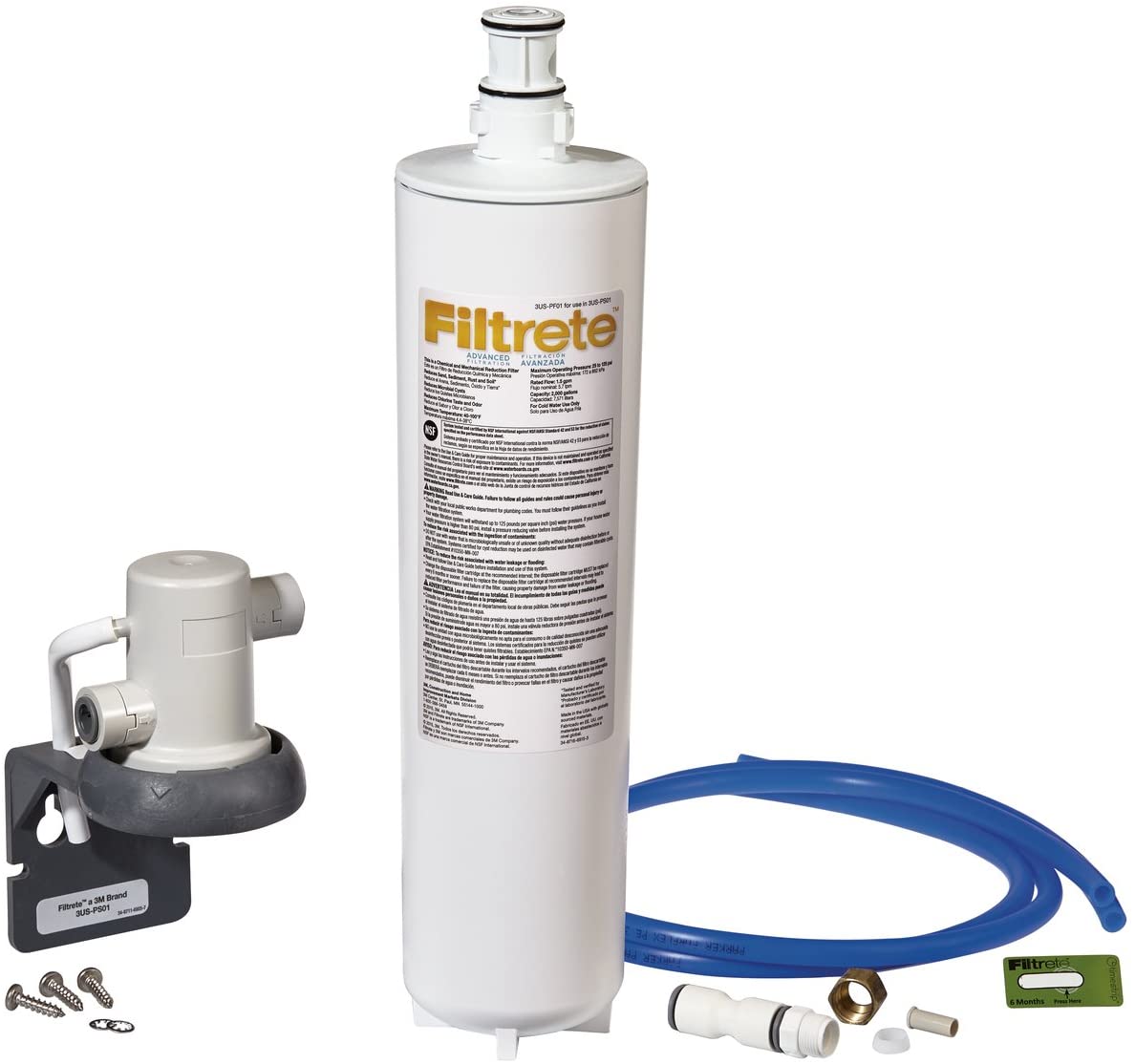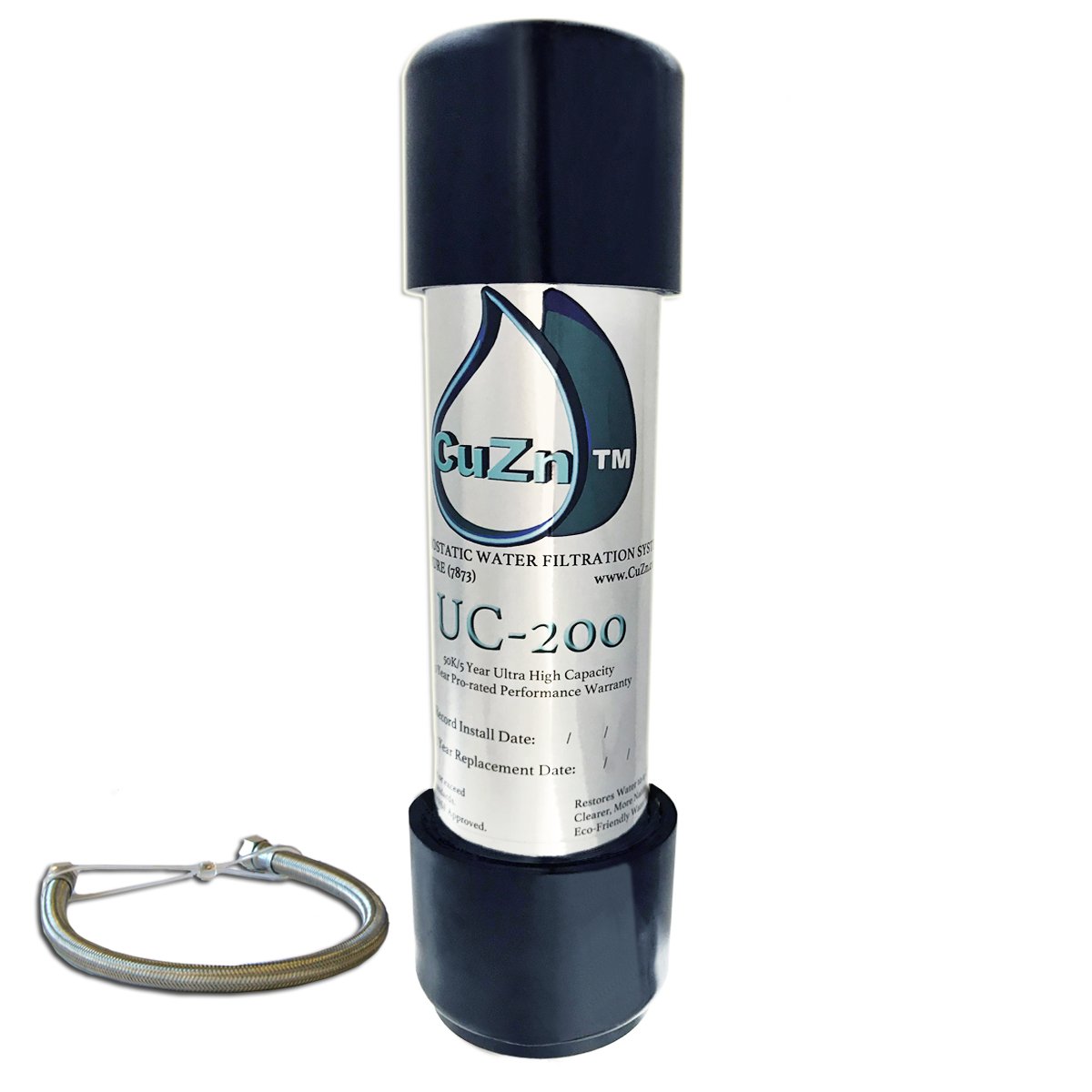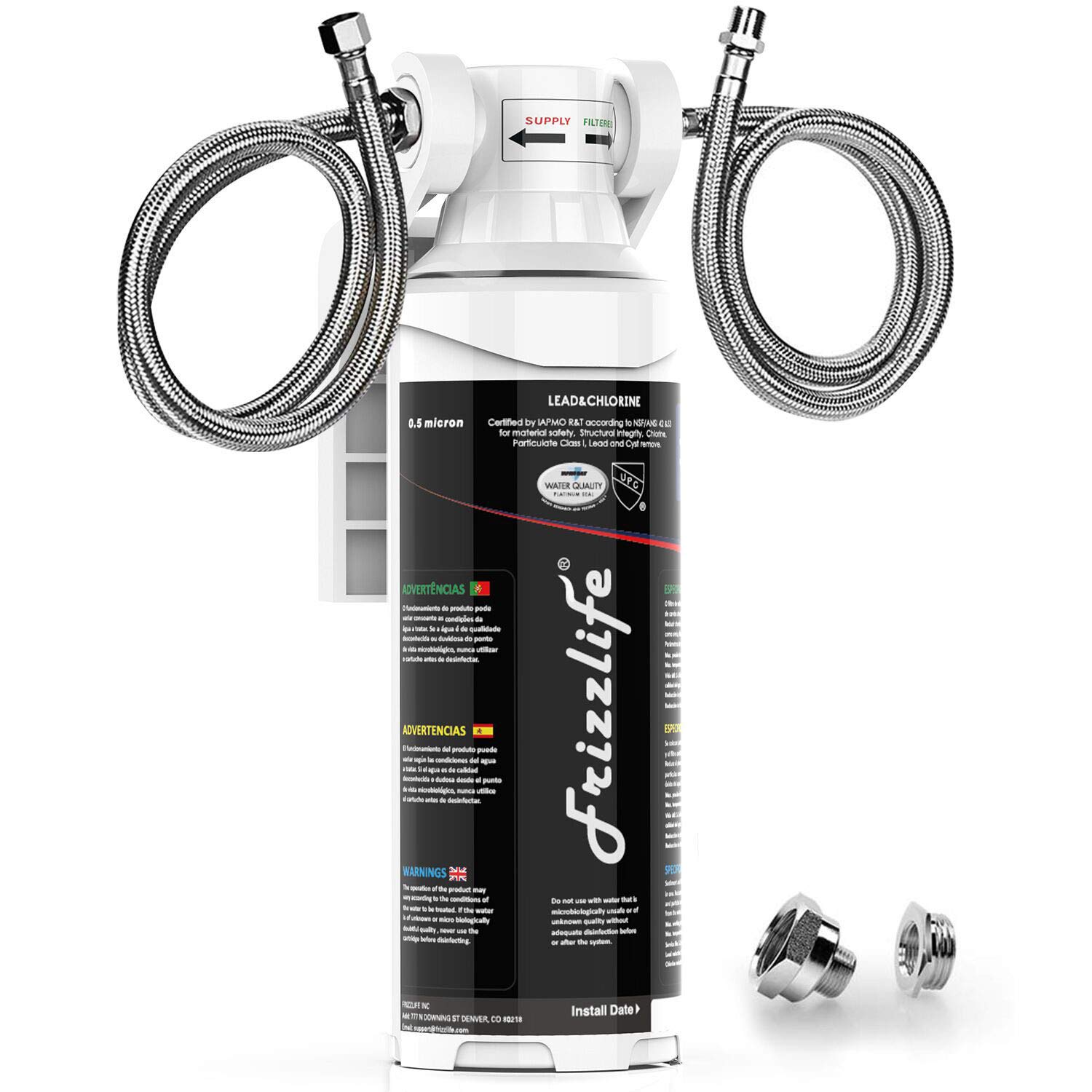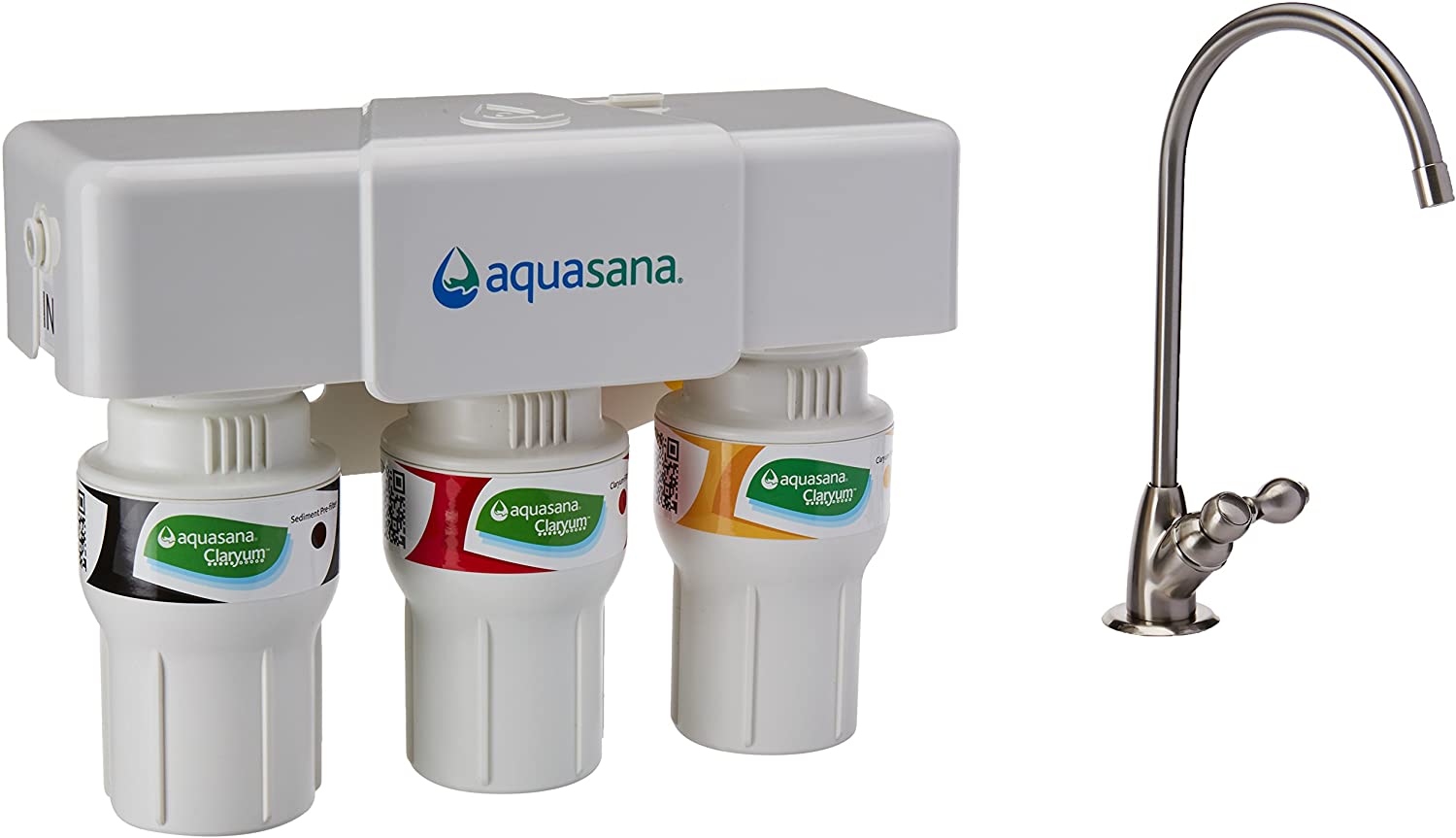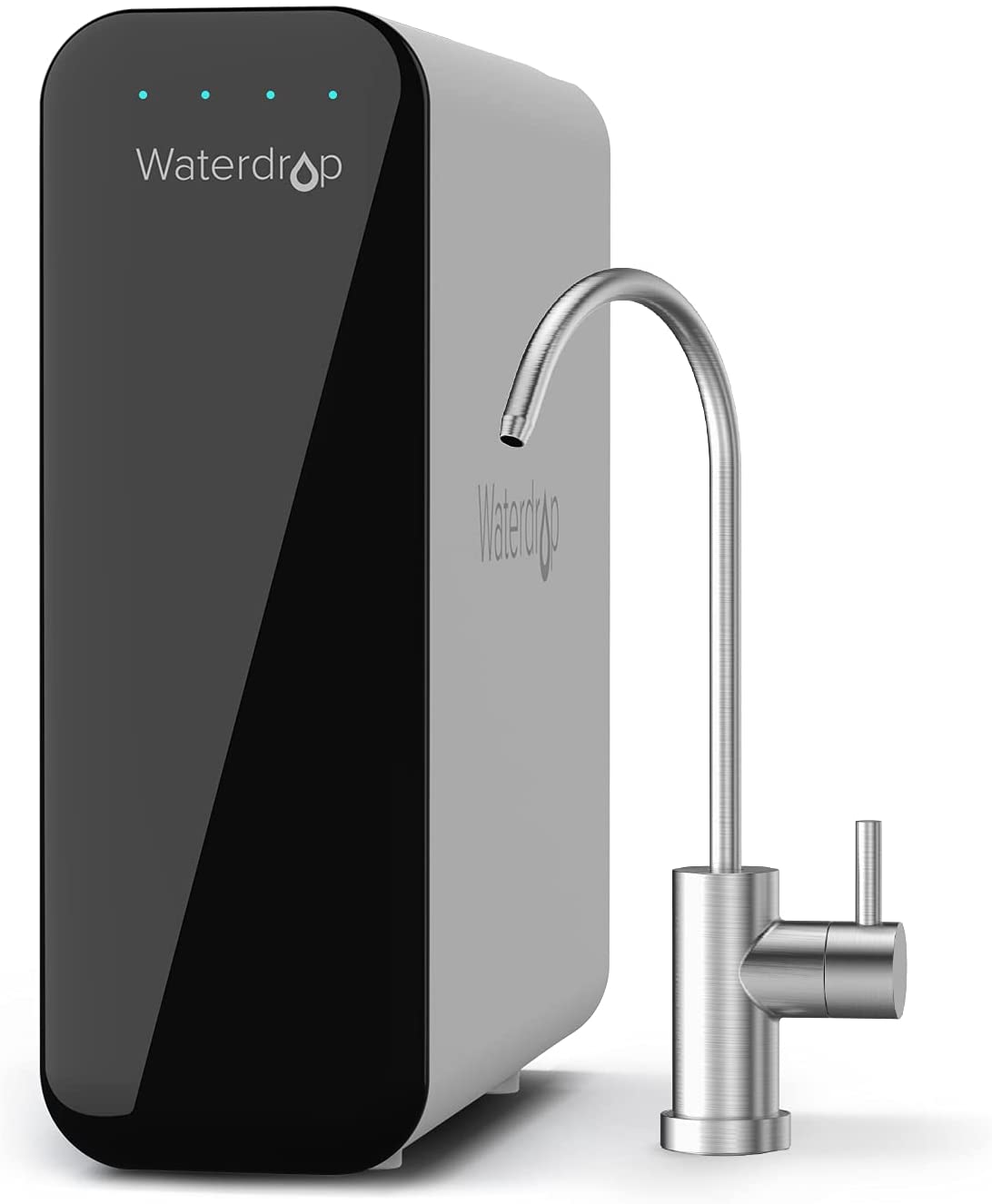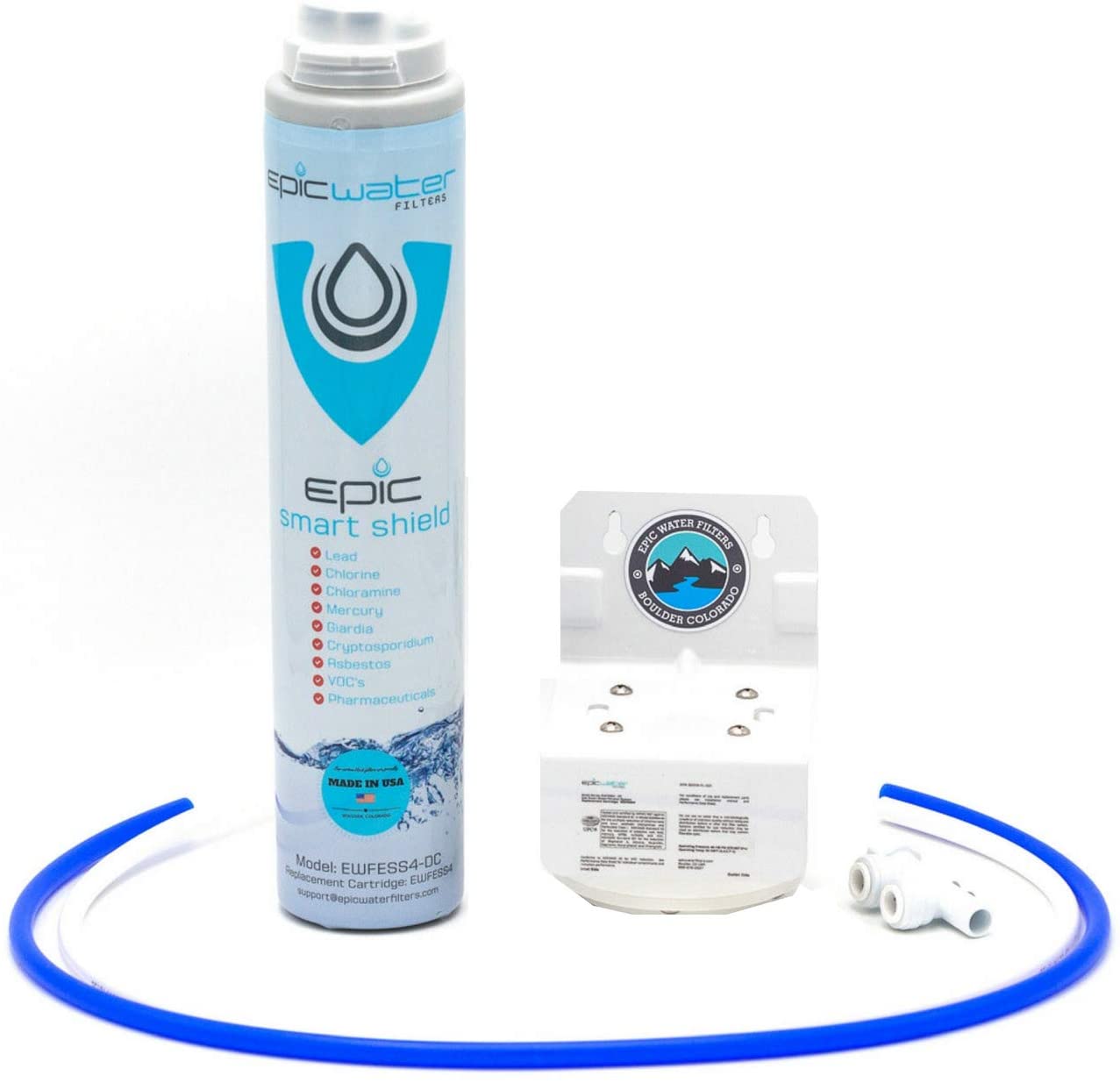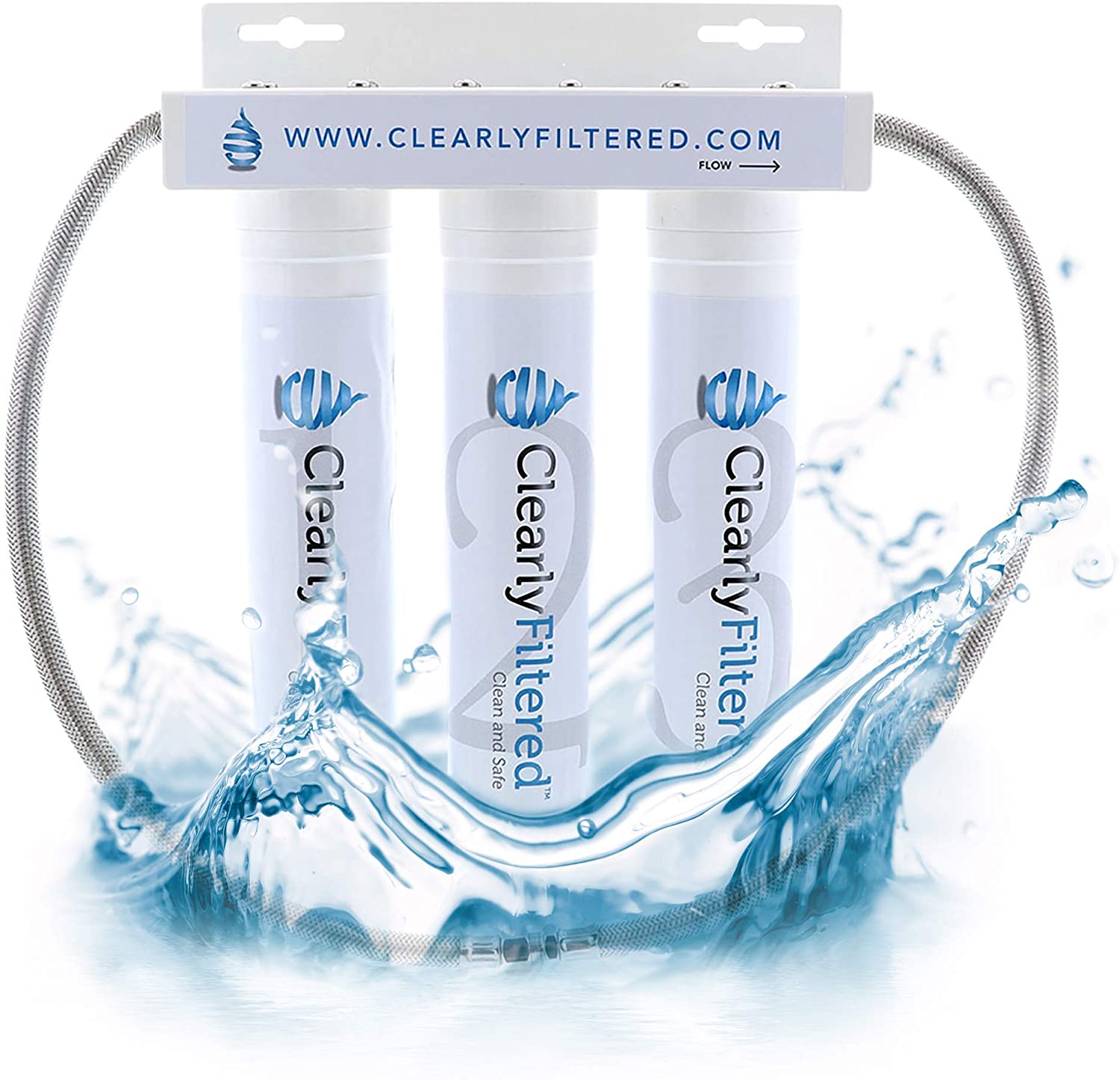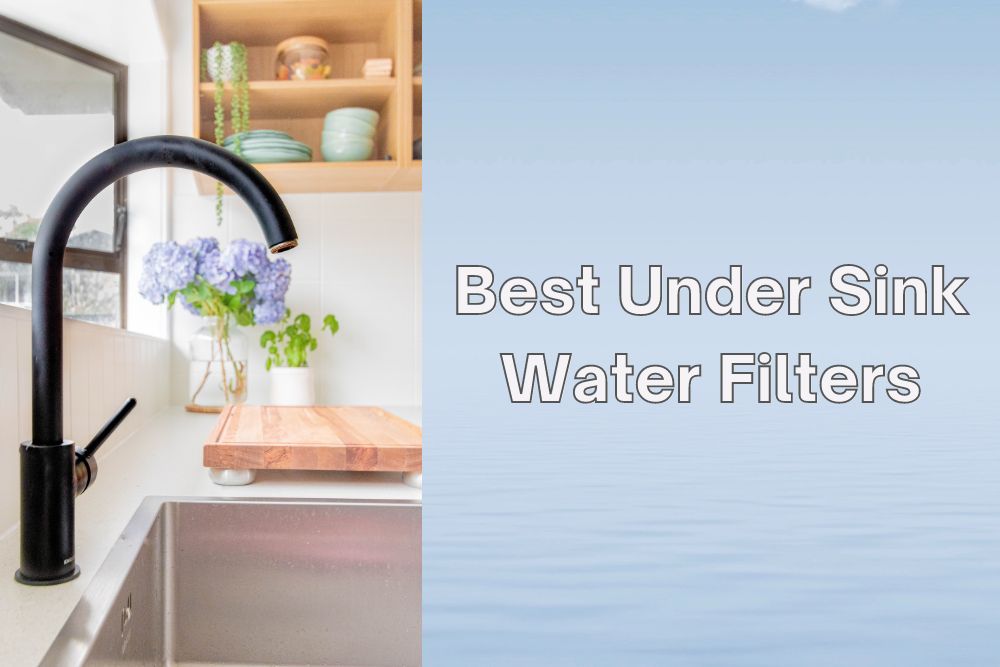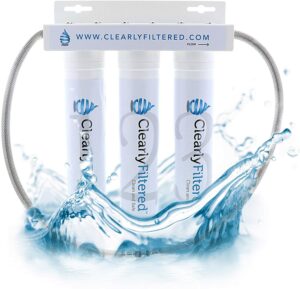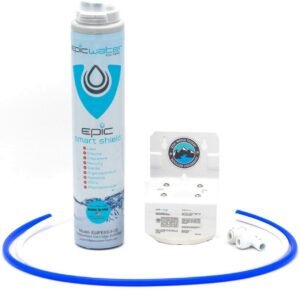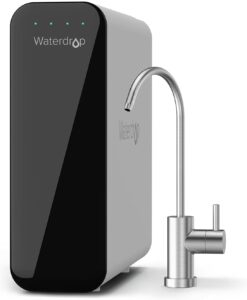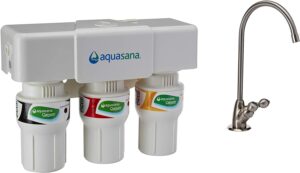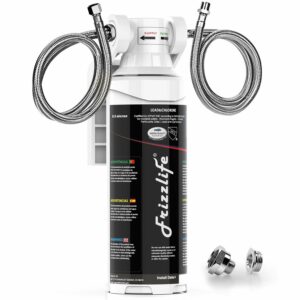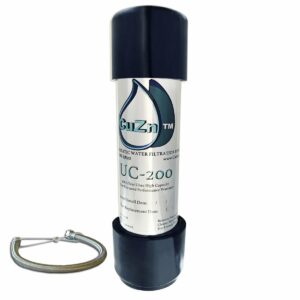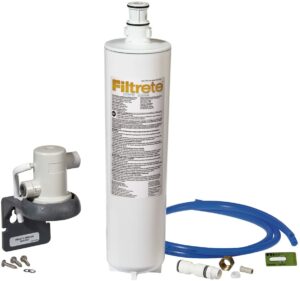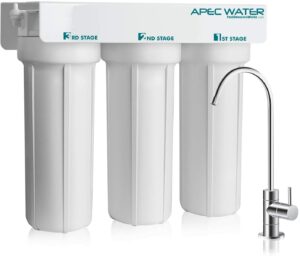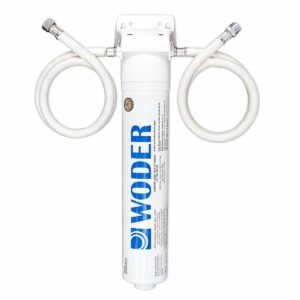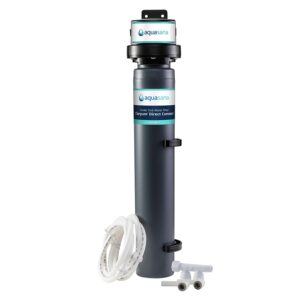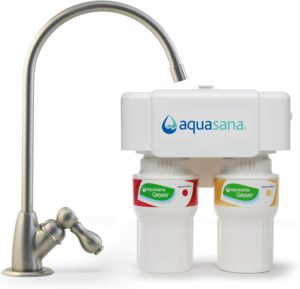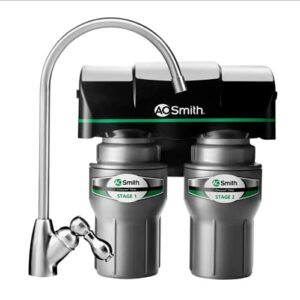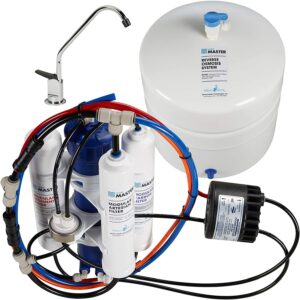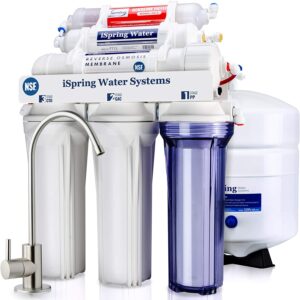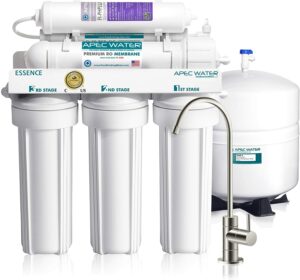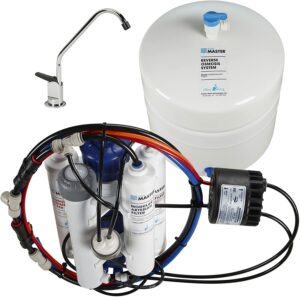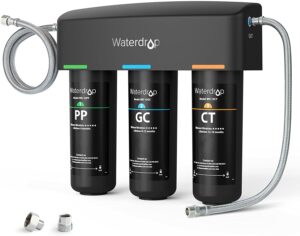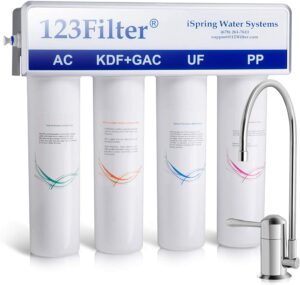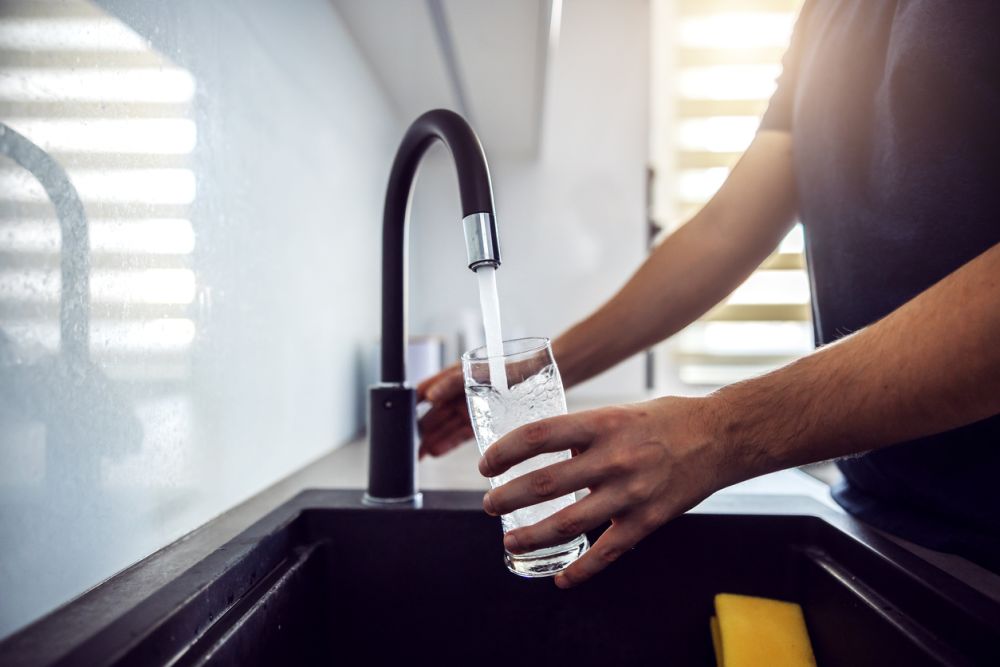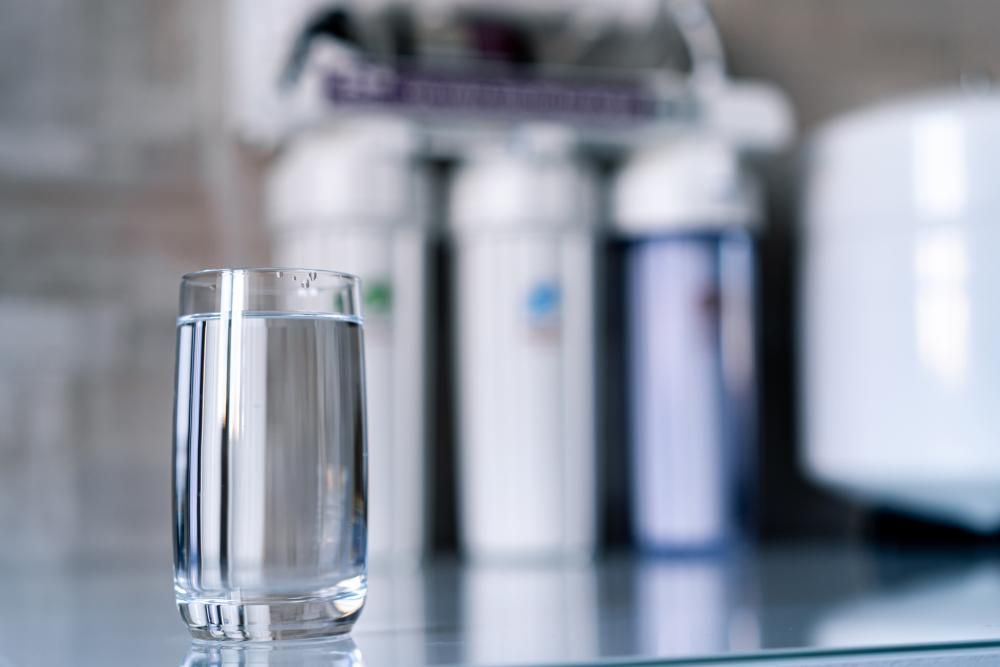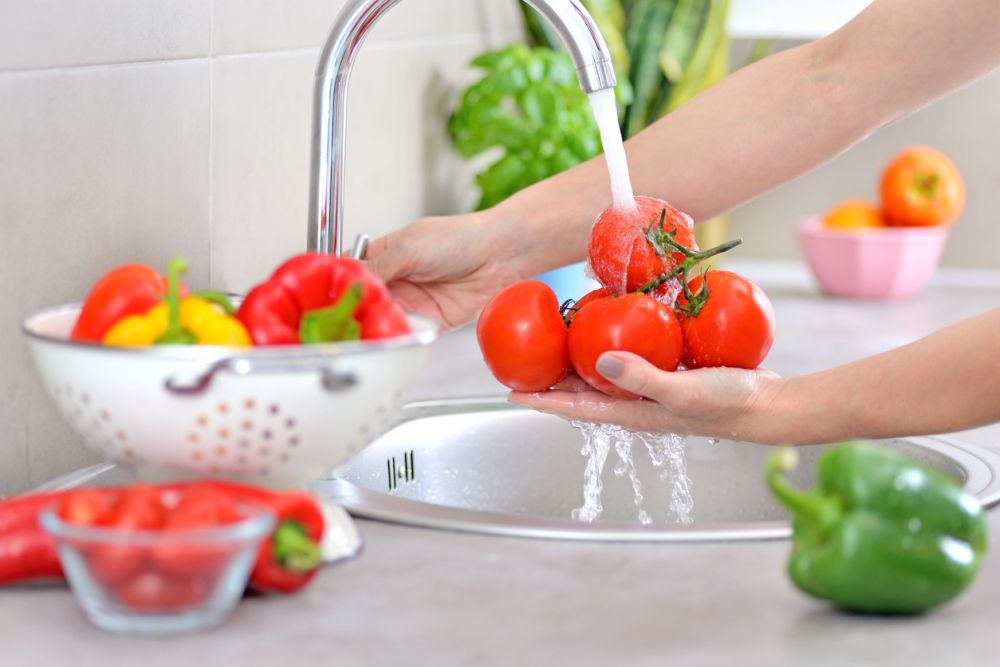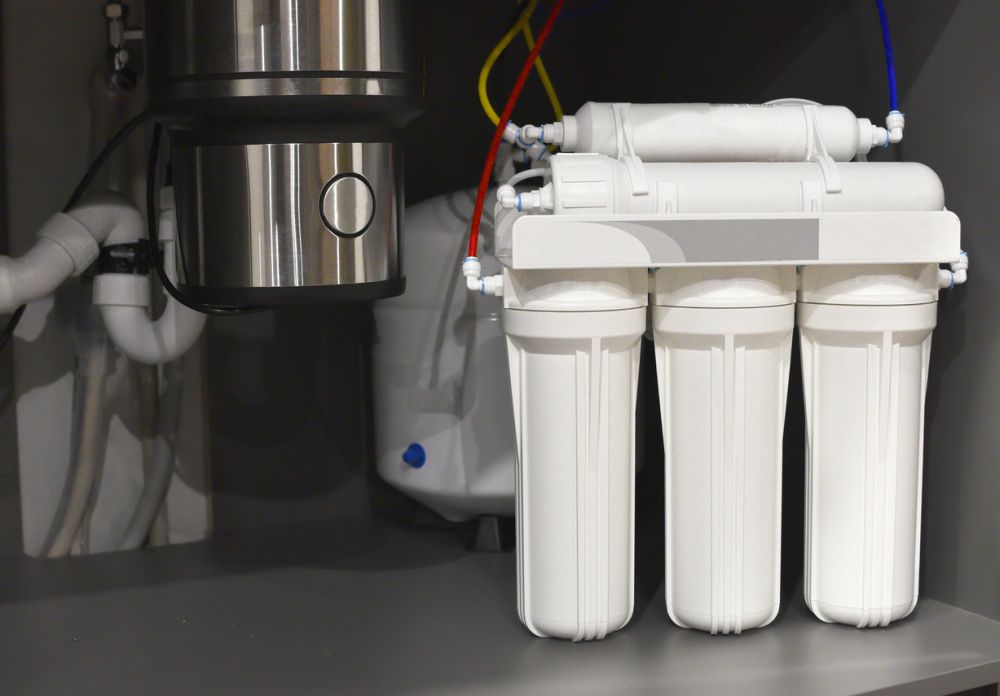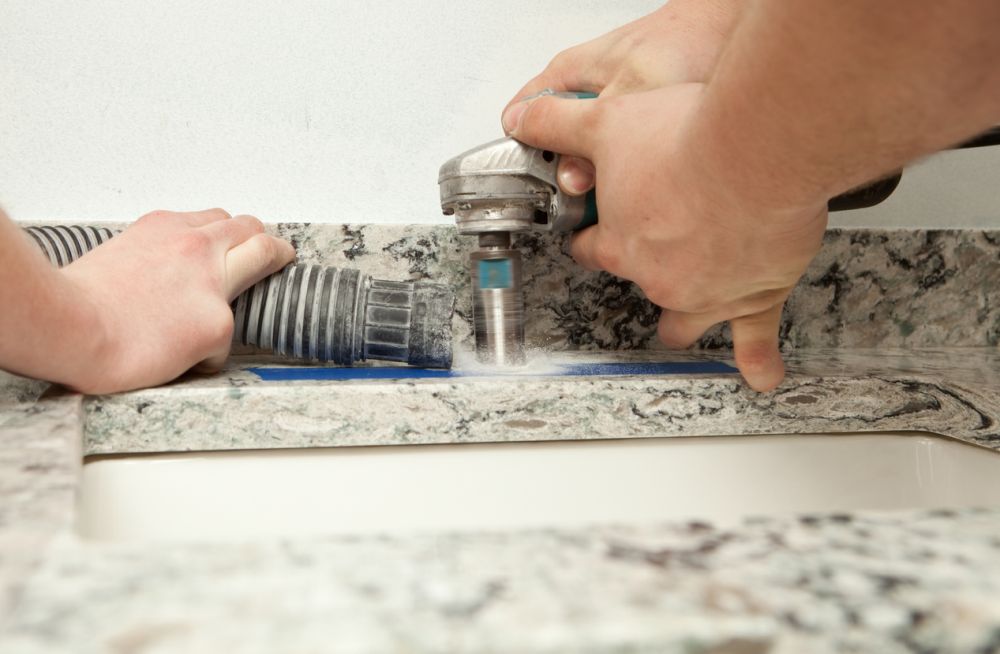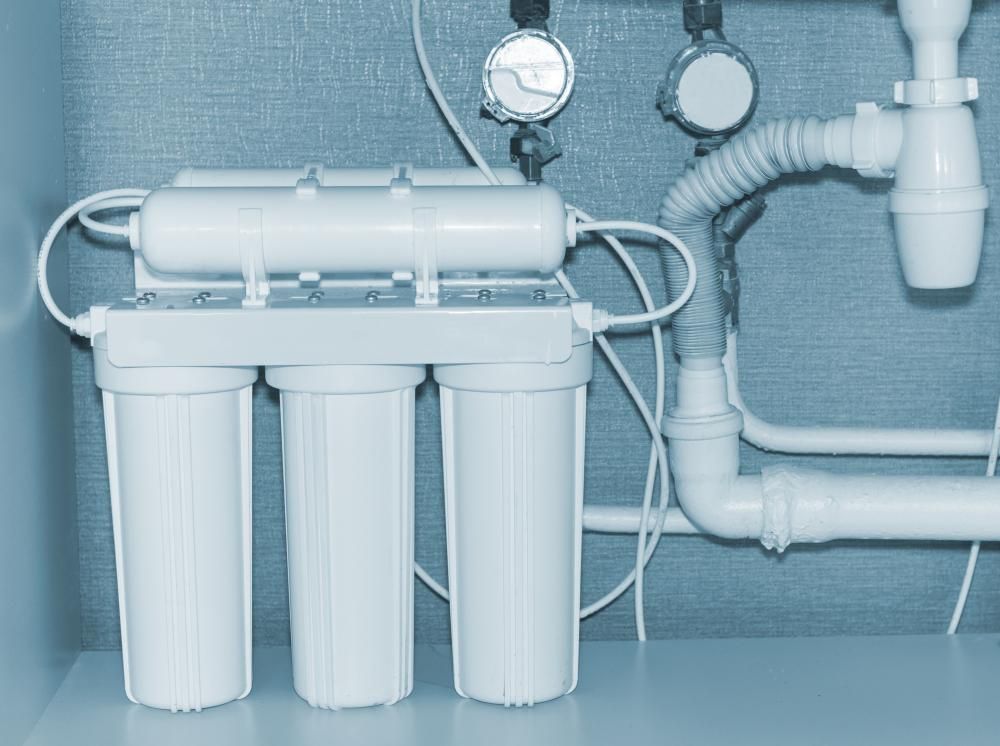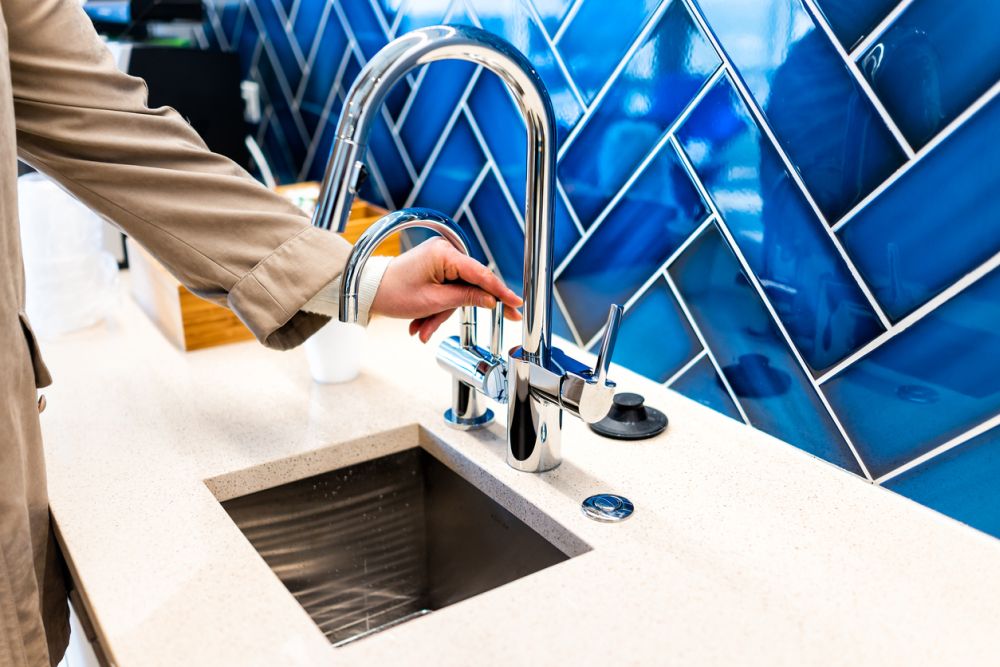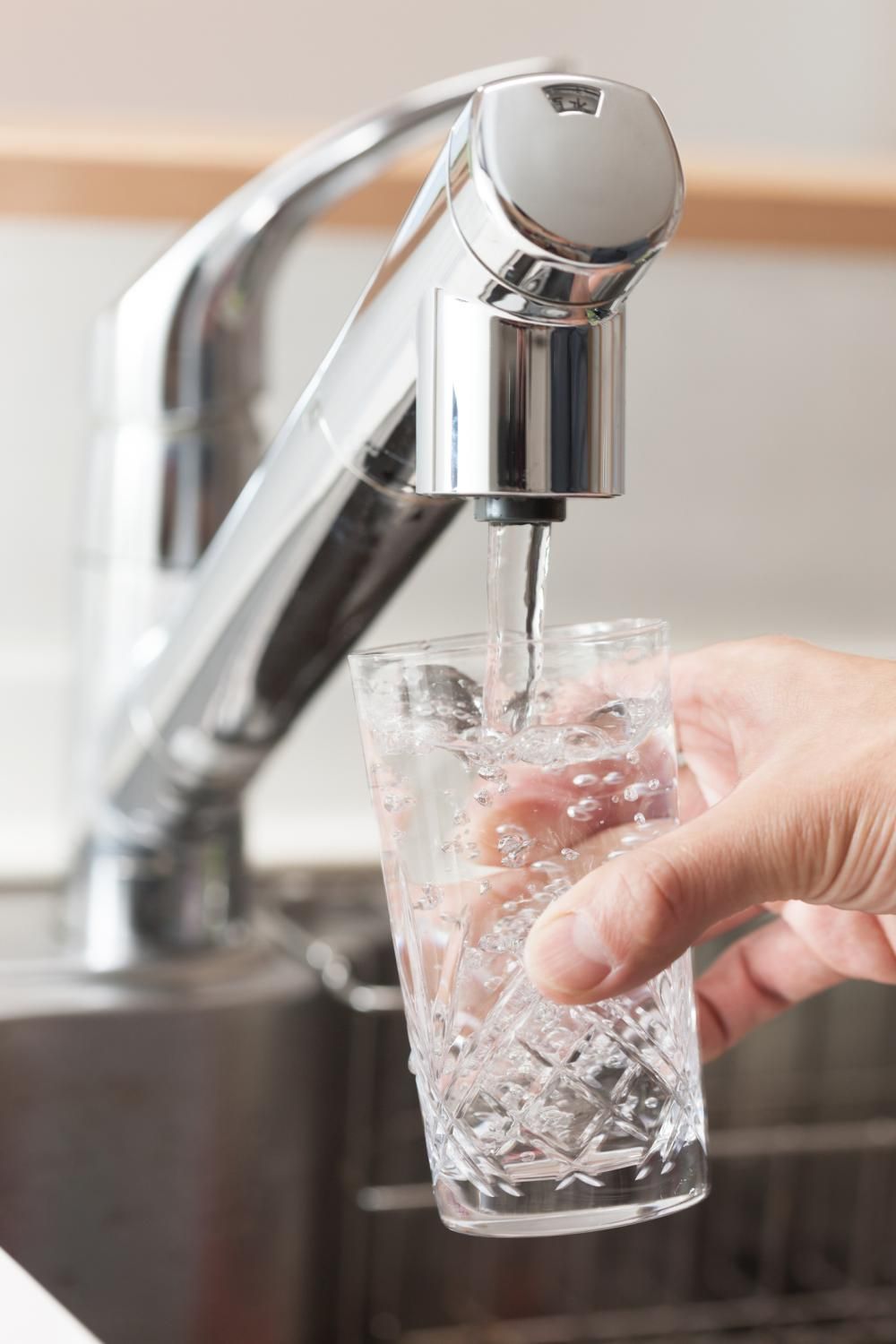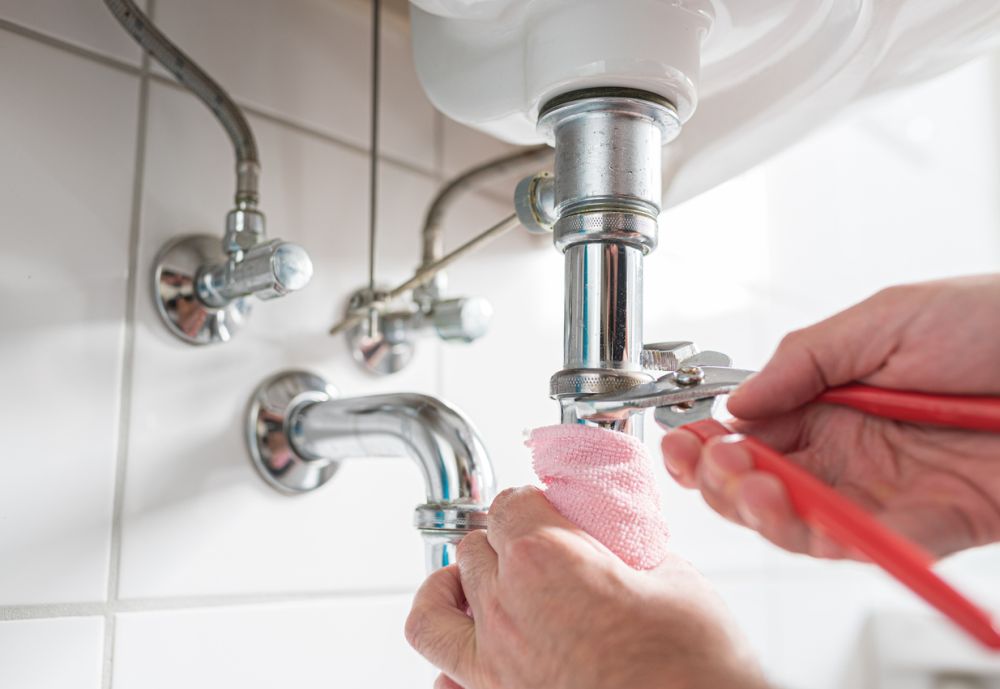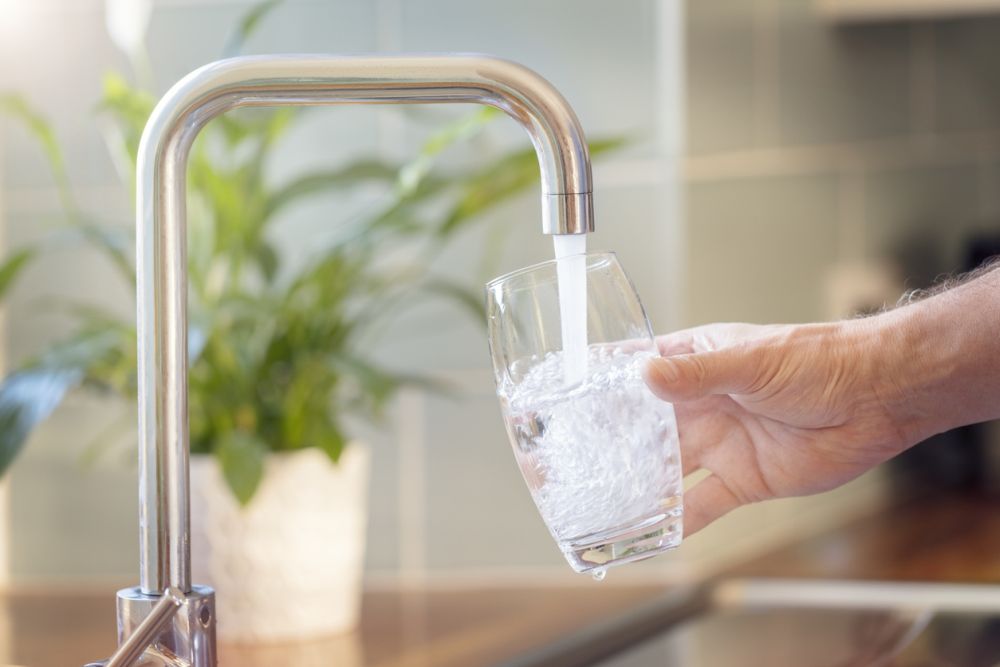19 Best Under Sink Water Filters to Enjoy Fresh and Clean Water
If you’re looking for a top-quality water filter that fits discreetly under your sink, we’ve got you covered! We reviewed the best under sink water filters so that you can find the perfect product and enjoy fresh, clean water every day.
Tap water isn’t safe to drink since it’s filled with various contaminants that slowly affect your health over time. Municipal tap water typically has a sour taste due to chlorine, while private well water contains heavy metals like lead, arsenic, and mercury.
If you’re looking for a safe way to drink water from your kitchen sink, get an under sink water filter. It’s an excellent alternative to faucet water filters.
It fits discretely in your kitchen cabinet under the sink, connects to your cold water line, and filters water to remove harmful contaminants and improve its taste. The system can filter water from your main kitchen sink or a secondary faucet, depending on the model.
Before buying an under sink water filter, you should research and find the best choices to learn the pros and cons of each product. We know that time isn’t on your side, so we tested and reviewed the top-rated under sink water filters.
Feel free to read our buying guide and learn more about this water purification method, including advantages and disadvantages, together with installation and maintenance tips.
Table of Contents
Best Under Sink Water Filtration Systems Reviewed
Now, let’s take a closer look.
1. Clearly Filtered Triple Stage Kitchen Faucet Filtration System
The Clearly Filtered Triple Stage Kitchen Faucet Filtration System is a reliable water filtering system that hooks up to your sink, removes dangerous contaminants from tap water, and enhances its taste to create delicious water that’s safe to drink by your entire family.
It uses three distinct filters to thoroughly purify water and remove more than 230 toxic chemicals.
Contaminants
This includes radioactive contaminants, MTBE, arsenic, fluorine compounds, pesticides, herbicides, bacteria, microbial cysts, hormones, copper, chloramine, chlorine, trace pharmaceutical drugs, aluminum, hexavalent chromium (Chromium-6), PFOA / PFOS, trihalomethanes (THM), fluoride, sulfur, microplastics, and lead.
At the same time, it retains all the beneficial minerals and nutrients that your body needs, such as calcium and magnesium.
The filters are leak-proof and long-lasting with a capacity of 2000 gallons. Large families should replace them once every 9 months, small families and couples every 12 months, and single individuals every 15 months.
Easy to install
The Clearly Filtered Triple Stage Kitchen Faucet Filtration System was specifically designed with tenants in mind, so it’s not necessary to drill into the kitchen countertop because it doesn’t need a separate faucet. Instead, it directly filters water coming out of your main spout.
A user-friendly instruction manual is provided for the installation process, so you don’t have to waste money hiring a plumber. It should take about 15 minutes to install the filtering system and change filters.
Durability
Durability isn’t an issue since the system is stainless steel. It measures 19.7 x 15.7 x 3.7 inches, weighs 6.8 pounds, and has been independently tested to NSF and EPA Standards 42, 53, 244, 401, and 473. Furthermore, the product comes with a lifetime guarantee.
Unfortunately, it doesn’t have a filter replacement indicator that tracks the number of gallons used and lets you know when it’s time to change the filters.
On top of that, the product is quite expensive when comparing it to other options on this list. And some customers reported having issues with low water pressure when using this unit.
Pros
- 4 filters remove over 230 water contaminants
- Long-lasting filters (up to 15 months)
- Easy to install
- Stainless steel design
- Lifetime guarantee
Cons
- Expensive
- No filter replacement indicator
- Some customers have problems with the water pressure
2. Epic Smart Shield Under Sink Water Filter
The Epic Smart Shield Under Sink Water Filter uses a solid carbon block water filter based on coconut shells to remove more than 70 common water impurities.
This includes chlorine, chloramine, bad taste and odor, lead, mercury, and other heavy metals, chemical resistant cysts like giardia and cryptosporidium, herbicides, pesticides, VOCs, and trace pharmaceuticals.
Healthy minerals are preserved in the water to protect your health. The filter has a capacity of 651 gallons, which should last for about 12 months.
Certifications
It was tested by NSF International and certified against NSF/ANSI Standards 42 (chlorine, taste, odor, particulates), 53 (cryptosporidium, lead, VOCs, asbestos), and 401 (herbicides, pesticides, detergents, emerging compounds, pharmaceuticals).
The Epic Smart Shield Under Sink Water Filter doesn’t need a separate faucet since it directly hooks up to your primary spout. As such, there’s no need to drill any holes in the kitchen counter, making it an excellent choice for tenants.
Easy to install
Plus, you can uninstall and reinstall it in a new home when you move. You don’t need to call a plumber and waste money since it’s pretty easy to set up, even if you are not exceptionally skilled in plumbing.
But the instructions are intuitive enough for anyone to understand. You just need an adjustable wrench and a standard Phillips head screwdriver.
Some downsides
The unit measures 7.09 x 1.77 x 3.15 inches and weighs 5 pounds. It can also be configured to run as a refrigerator with an inline water filter. Unfortunately, although it’s BPA-free, we’re talking about plastic, which doesn’t feel very durable.
On top of that, it doesn’t have a filter replacement indicator, so there’s no way of accurately knowing when it’s the right time to change it. And some customers reported trouble with installing the unit on their own, despite the manufacturer’s reassurance.
Pros
- Removes over 70 common contaminants
- Long-lasting filters
- Certified by the NSF
- Affordable price
Cons
- The plastic material doesn’t feel durable
- No filter replacement indicator
- Some customers had trouble with the setup
3. Waterdrop WD-TSU-W 3-Stage Ultra Filtration Under Sink Water Filter System
The Waterdrop 3-Stage Ultra Filtration Under Sink Water Filter System uses three filters to get rid of nasty water contaminants and produce tasty water that you can safely drink.
Specifically, it has a PP filter that eliminates large particles and other impurities, a UF filter that gets rid of 100 common contaminants, as well as a CT filter that removes chlorine, lead, and other heavy metals. It focuses on any harmful substances larger than 0.01 microns.
But it preserves the good minerals in the water since it can’t remove TDS. So you will still be able to take advantage of potassium, calcium, sodium, magnesium, and other nutritious minerals.
Filter replacement indicator
The UF filter lasts for 24 months, the CT filter for 12 months, and the PP filter for 6 months. You don’t have to worry about taking notes and monitoring the lifespan of each filter since the Waterdrop has an intelligent notification system that changes light color when it’s time to switch the filters.
It’s quite easy to install the Waterdrop 3-Stage Ultra Filtration Under Sink Water Filter System in just a few minutes. It’s even easier to replace the filters in several seconds by twisting and pulling. You don’t have to cut off the water supply, thanks to an integrated waterway that prevents leaks.
Runs on batteries
And, you don’t need a wall socket under the sink because the Waterdrop doesn’t run on electricity. Instead, it requires 3 AA batteries.
However, it comes with a separate faucet, which means you have to screw it into your kitchen countertop using power tools. If you’re not handy, this means hiring professional help. Moreover, this water filtering system doesn’t work for tenants who aren’t allowed to make permanent changes to their homes.
Fantastic water flow
The unit is mostly plastic with a brushed nickel finish, but the faucet is stainless steel. It measures 19.2 x 19 x 7 inches and weighs 14.72 pounds.
The water flow is excellent at 0.5 GPM since you can fill a glass of water in about 6 seconds. It’s certified by the NSF, WQA, and IAPMO, although no details are available about this.
Pros
- High-end, compact design
- Replace filters in just a few seconds
- Filter replacement indicator
- Long-lasting filters
- No electricity (runs on batteries)
Cons
- Requires drilling
- Professional help might be required for installation
- Doesn’t work for tenants
- No details about certifications
4. Aquasana 3-Stage Water Filter System
The Aquasana 3-Stage Water Filter System removes up to 99% of 77 contaminants using three filters.
This includes rust, sediment, silt, chloramine, lead, mercury, and other heavy metals, microbial cysts like cryptosporidium and giardia, pharmaceuticals, herbicides, pesticides, VOCs, and other chemicals. However, the beneficial minerals remain in the water since it can’t remove TDS.
Great flow rate
The flow rate is excellent since it can pour water at 0.5 GPM, so you don’t need to wait forever to get a glass filled. It’s incredibly easy to replace the three filters without disconnecting the hoses and water lines. Instead, you twist off each filter and put in a new one.
The Aquasana 3-Stage Water Filter System is metal with a nickel finish. It measures 12 x 4.25 x 9 inches and weighs 6 pounds. The product was tested by NSF International and certified against NSF/ANSI Standards 42, 53, 401, and P473.
Runs on batteries
It’s unnecessary to install a wall socket under the sink since the Aquasana doesn’t run on electricity. Instead, it requires a lithium metal battery, which is included in the purchase. Plus, it comes with a 1-year warranty.
On the downside, the filters are not long-lasting. They have a capacity of 600 gallons, which means replacing them once every 6 months.
Downsides
There’s no filter replacement indicator either, making it challenging to keep track of the 600-gallon water consumption – you just have to write down the starting date and remember to change it 6 months later.
On top of that, it’s necessary to install a secondary faucet for the filtered water, which means making holes in your kitchen countertop and screwing the spout in. If you’re renting an apartment and aren’t allowed to make permanent modifications, the Aquasana won’t work for you.
Pros
- Three filters remove 77 contaminants
- Easy to change filters
- Certified by the NSF
- No electricity (runs on batteries)
Cons
- Short filter lifespan
- No filter replacement indicator
- No stainless steel materials
- Requires drilling
- Professional help might be required for installation
- Doesn’t work for tenants
5. Frizzlife MK99 Under Sink Water Filter System
The Frizzlife MK99 Under Sink Water Filter System takes a unique approach to decontaminating tap water.
It uses a single filter cartridge that has the role of 2 distinct filters – a sediment filter and an activated carbon block, resulting in a two-stage purification process.
It eliminates over 99.99% of lead, arsenic, chlorine, Chromium-6, mercury, rust, VOCs, carcinogens, turbidity, bad taste and odor, fluoride, microbial cysts, copper, sand, and any other impurities with a size of at least 0.5 microns.
Can’t remove TDS
However, the unit can’t reduce TDS like a reverse osmosis system, so it retains all the beneficial organisms that human organisms need, including magnesium, calcium, potassium, sodium, and essential minerals. It has been tested by IAMPO R&T and certified against NSF Standard 42 and 53.
The filter should last for 1 year, and changing it can be done in under 3 minutes. The filter cap has an integrated shut-off valve so that you don’t need to manually cut off the water supply during filter replacements. There’s no separate faucet, connecting directly to your kitchen faucet.
Water pressure
As far as the flow rate and water pressure are concerned, the Frizzlife pours water at 2 GPM and 60 PSI. And compared to other under-the-sink water filtering systems, this model requires you to change only the core of the filter cartridge instead of throwing out the entire plastic casing, which is better for the environment.
Hiring an expert is unnecessary since you can quickly hook up the water filtering system under your sink and attach it to the pipes. It comes with cold water tubes of standard size, together with extra converters.
Runs on batteries
Plus, since the system runs on batteries, you don’t need to plug it into a power socket. And, if you are renting a place, you can easily uninstall the unit, pack it up, and install it at your next place.
The Frizzlife MK99 Under Sink Water Filter System weighs 4.20 pounds and measures 5 x 5 x 13.5 inches. It comes with a 3-year warranty that you can extend to 4 and a half years if you register with the manufacturer.
Unfortunately, it doesn’t come with a filter replacement indicator. And some customers have complained that their filter cartridge got clogged in just a few months.
Pros
- Compact design
- Certified against NSF standards
- Easy to install
- No electricity required (runs on batteries)
- Excellent flow rate
Cons
- No filter replacement indicator
- The filter might get clogged sooner than expected
6. CuZn UC-200 Under Counter Water Filter
The CuZn UC-200 Under Counter Water Filter has an incredible capacity of 50,000 gallons or 5 years (whichever comes first), so you don’t need to worry about changing the filter often. It’s designed for municipal water only, so you shouldn’t use it with a private well.
It doesn’t have a separate faucet, so you must connect it to your plumbing system to filter tap water that flows through your primary faucet. The system is easy to install and comes with intuitive instructions, so you don’t have to turn to a plumber.
Three-stage filtering
Water is filtered in three stages. Firstly, a micro-sediment membrane handles undissolved particulates, sand, and other coarse impurities. Secondly, an acid-washed coconut shell activated carbon targets lousy taste and odor, chlorine, THMs, herbicides, pesticides, and other organic contaminants.
Thirdly, a powerful KDF-55 filtration media prevents bacteria growth and takes care of inorganic contaminants like lead and other heavy materials. TDS doesn’t get removed, so you will still be able to drink clean water with all the nutritious minerals like potassium or calcium.
5-year warranty
The CuZn UC-200 Under Counter Water Filter weighs 7.89 pounds, measures 4.5 x 4.5 x 15 inches, and has an excellent flow rate of 2 GPM. Its connection hose is stainless steel, so you don’t have to worry about its durability. It comes with a 5-year warranty and a 90-day satisfaction guarantee.
The unit has been tested to NSF Standard 42 and 61. However, it’s unclear whether or not it passed the test, and you can’t find any information about it in the online database of NSF International. On top of that, the design is a bit bulky and might not fit under specific sink sizes.
Pros
- Removes contaminants using three filters
- Very long filter lifespan (best on this list)
- Easy to install
Cons
- Bulky design
- Doesn’t work with private wells
- Tested but not certified by the NSF
7. Filtrete Advanced Under Sink Quick Change Water Filtration System 3US-PS01
The Filtrete Advanced Under Sink Quick Change Water Filtration System 3US-PS01 is a tiny system that fits anywhere, whether you want to set it up in your kitchen or bathroom.
No additional faucet is required since the water filtering system connects directly to your pipes.
So you don’t need to drill any holes and use any screws, making it an excellent choice for tenants who are not allowed to make permanent changes to their apartments.
Portable water filter
Besides, you can uninstall the unit, pack it up, and install it in your new place when you move out. And you don’t have to hire a professional since you can effortlessly set it up using an adjustable wrench and a screwdriver.
The Filtrete Advanced Under Sink Quick Change Water Filtration System 3US-PS01 removes chlorine, bad taste and odor, sand, soil, rust, sediments, microbial cysts, and other contaminants with a size of at least 0.5 microns.
Long-lasting filters
The filter lasts for 6 months and can be easily changed. It’s certified by NSF/WQA, although no additional information is required. The unit measures 4 x 6.8 x 14 inches and weighs 3.12 pounds. You can get it at an affordable price.
However, it’s not as efficient as other under-the-sink water filter systems when it comes to the array of contaminants. For instance, it can’t remove heavy metals like lead. On top of that, some customers complained that it lasted less than 6 months as advertised.
Pros
- Easy to install
- Good filter capacity
- Super affordable (cheapest on this list)
- No drilling necessary
Cons
- Can’t remove too many contaminants
- Insufficient information about NSF certifications
- Might not last 6 months as advertised
8. APEC WFS-1000 Super Capacity Premium Quality 3 Stage Under-Sink Water Filter System
The APEC WFS-1000 Super Capacity Premium Quality 3 Stage Under-Sink Water Filter System uses three distinct filters to remove contaminants from unfiltered tap water thoroughly.
A carbon block gets rid of chemicals, taste and odor, a sediment filter handles dust, particles and rust, while an extra carbon block takes care of chlorine, cloudiness, VOCs, and other harmful effects. But it can’t remove heavy metals like lead or arsenic.
Can’t remove TSD
Unlike a reverse osmosis system, it can’t remove TDS, preserving all beneficial minerals that your organism needs, including potassium, magnesium, and sodium. The filters should last for 1 year and have been certified by a WQA specialist, although no additional details are available.
The APEC WFS-1000 Super Capacity Premium Quality 3 Stage Under-Sink Water Filter System is polypropylene, measures 6 x 15 x 12 inches, weighs 14 pounds, and requires water pressure between 20 and 85 PSI.
Secondary faucet
It comes with a secondary faucet, but installing it is optional. If you’re renting and can’t make permanent changes to your apartment, you should connect the APEC directly to your kitchen sink.
Otherwise, you can set up a lead-free and food-grade secondary faucet to bypass the filtering mode now and then. However, you have to drill in your kitchen countertop, which means hiring a professional if you’re not handy with power tools.
The unit includes a 1-year satisfaction guarantee and lifetime support. Unfortunately, it can’t remove as many contaminants as other products from this list. Plus, the unit itself isn’t certified by NSF International.
Pros
- Uses three filters
- Long-lasting filters
- A secondary faucet is optional
Cons
- Not certified by the NSF
- Can’t remove too many contaminants
- Can’t remove heavy metals like lead or arsenic
9. Woder WD-S-8K-DC Water Filtration System
The Woder WD-S-8K-DC Water Filtration System has an impressive filter capacity of 8,480 gallons for private well water. If you use it with treated cold water from the city, it will last even longer.
This product gets rid of more than 99.99% of chlorine, bad taste and odor, lead, mercury, chromium-6, VOCs, carcinogens, turbidity, and other harmful effects.
It was tested by NSF International and certified against Standards 42 and 372 – the latter proves that the unit is lead-free.
Water flow rate
The water flow rate and pressure are pretty impressive at 2 GPM and 65 PSI. You can easily install the filtering system under your sink by taking advantage of Direct Connect hoses that fit standard valves of 3/8 inches. So it works with both kitchen and bathroom sinks.
Since it doesn’t come with a faucet, you don’t have to drill any holes in your countertop. So you can use this water filter system even if you live in an RV or if you’re a tenant who’s not allowed to make any permanent modifications to their apartments.
Easy to set up
And it makes it easier to uninstall the Woder WD-S-8K-DC, pack it up, and then set it up in a new apartment when you move out.
The Woder WD-S-8K-DC Water Filtration System measures 3 x 3 x 15 inches and weighs 2.82 pounds. It’s BPA-free plastic, though, which might put off many potential customers since it doesn’t feel very durable.
Pros
- Easy to install
- Long-lasting filter
- Certified by the NSF
- Removes heavy metals
- No drilling required
Cons
- Not that efficient with private well water
- The plastic material doesn’t feel durable
- The flow rate gets reduced over time
10. Aquasana Claryum Direct Connect Under Sink Water Filter System
The Aquasana Claryum Direct Connect Under Sink Water Filter System can be easily installed on a cold water line without drilling a hole in the kitchen counter and adding a secondary sink, making it ideal for tenants.
As far as efficiency goes, it uses a carbon filter to remove up to 99% of 77 contaminants from tap water, including lead, mercury, asbestos, herbicides, pesticides, and pharmaceuticals.
At the same time, the Claryum preserves beneficial minerals like calcium, magnesium, and potassium. However, remember that it can’t remove TDS since it’s not a reverse osmosis system.
Certifications
It was tested and certified to NSF/ANSI Standard 42 for chlorine, taste, odor, and particulates, NSF/ANSI Standard 53 for cryptosporidium, lead, VOCs, and asbestos, NSF/ANSI Standard 401 for herbicides, detergents, emerging pesticides, and pharmaceuticals, as well as NSF/ANSI Standard P473 for PFOA and PFOS.
The filter has a capacity of 784 gallons, which should last for about 6 months. According to the manufacturer, you should be able to fill 6,250 bottles of water before replacing the filter. Furthermore, it has a flow rate of up to 1.5 GPM.
Easy to install
When installing the filtering system, you can just place it under the sink cabinet laid down. Or, if you need the space, use the mounting brackets to secure it horizontally or vertically.
The Aquasana Claryum Direct Connect Under Sink Water Filter System measures 4 x 4 x 20.5 inches and weighs 4.96 pounds. Unfortunately, it’s plastic, which doesn’t feel very durable.
It also doesn’t have a filter placement indicator, which would have helped keep track of the entire family’s water consumption. Some customers have complained about the water flow rate, claiming that it decreases over time.
Pros
- Easy to install
- No extra faucet or drilling required
- Removes 77 contaminants
- Certified by the NSF
Cons
- The plastic material doesn’t feel durable
- Flow rate decreases over time
- No filter replacement indicator
11. Aquasana AQ-5200 2-Stage Under Sink Water Filter System
The Aquasana AQ-5200 2-Stage Under Sink Water Filter System uses two filters to decontaminate tap water thoroughly. An activated carbon block reduces herbicides, pesticides, VOCs, MTBE, and other organic chemicals.
Meanwhile, a catalytic carbon eliminates chlorine and chloramine, while an ion-exchange filter reduces heavy metals like lead and mercury.
Overall, the Aquasana can get rid of 77 contaminants while preserving the nutrients like magnesium, calcium, and potassium, which are necessary for hydration.
Certifications
The Aquasana AQ-5200 2-Stage Under Sink Water Filter System was tested by NSF International and certified against NSF Standards 42, 53, 401, and P473. Its filters have a 500-gallon capacity that should last 6 months, depending on how many people live in your household.
Thankfully, the AQ-5200 has a filter replacement indicator that lets you know exactly when it’s time to change the filters without second-guessing. The first pair of filters are included in the initial purchase; they have a twist-off design to change them yourself easily.
Can be tricky to install
However, you must drill a hole in your kitchen sink to install a secondary faucet. If you’re not handy with power tools, you must hire a plumber in this case. And, if you’re not allowed to drill holes at your place, you can’t use this product.
The system measures 8.25 x 4.25 x 9 inches, weighs 0.8 ounces, and has a 0.5 GPM flow rate. It’s metal with a chrome or brushed nickel finish, depending on your preference. It requires a lithium metal battery, so you don’t need a wall socket under the sink. The product comes with a 1-year warranty.
Pros
- Removes 77 contaminants
- Certified by the NSF
- Filter replacement indicator
- Runs on batteries (no electricity required)
Cons
- Can’t be used by tenants who are not allowed to drill holes
- Metal, not stainless steel
12. AO Smith AO-US-200 2-Stage Under Sink Clean Water Faucet Filter
The AO Smith AO-US-200 2-Stage Under Sink Clean Water Faucet Filter gets hooked up to your cold water line to purify water and remove up to 99% of 77 contaminants, including lead, mercury, asbestos, pesticides, pharmaceuticals, chlorine, and chloramine.
Thanks to advanced filtration, beneficial minerals like calcium, potassium, and magnesium remain in the water since the AO Smith doesn’t remove TDS.
Different filter types
It uses an activated carbon block, catalytic carbon, ion exchange, and absolute sub-micron mechanical filtration.
The entire system is certified against NSF/ANSI Standards 42, 43, 401, and +P473. It has a filter capacity of 500 gallons, which should last 6 months. Plus, it weighs 4.85 pounds, measures 11.73 x 8.66 x 5.67 inches, and pours water at a 0.5 GPM flow rate.
Separate faucet
The AO Smith AO-US-200 2-Stage Under Sink Clean Water Faucet Filter comes with a separate faucet, which means that it’s necessary to drill it into your kitchen counter to draw filtered water.
If you are not allowed to do that in your rented place, this system won’t work for you. Plus, you have to pay a plumber to set it up if you are not skilled with power tools.
On the bright side, the AO Smith doesn’t run on electricity, so you don’t have to install a new wall socket under the kitchen counter. Instead, you have to supply it with a lithium metal battery.
Pros
- Removes 77 contaminants
- Certified by the NSF
- Runs on batteries
Cons
- Requires drilling
- Not suitable for tenants
- Filter replacements are expensive
13. Home Master TMAFC-ERP Under Sink Water Filter
The Home Master TMAFC-ERP Under Sink Water Filter uses a reverse osmosis system to remove all contaminants and TDS from water.
It thoroughly filters water in 7 stages, eliminating up to 98% of contaminants. This includes chlorine, chemicals, metals, fluoride, TDS, pharmaceuticals, and microplastics. However, it can’t remove iron or destroy viruses and microorganisms with UV.
It also features a catalytic carbon filter to eliminate chloramine, an activated carbon filter based on coconut shells, together with an artesian remineralization filter.
Separate faucet
The Home Master TMAFC-ERP Under Sink Water Filter comes with a separate faucet, so you must drill a hole in your sink countertop.
If you’re not skilled in using power tools, you have to hire a professional. Furthermore, this option isn’t for you if you are currently renting a home and are not allowed by your landlord to make any permanent changes.
Impressive filter capacity
The system has a filter capacity of 2000 gallons, which is pretty impressive. It measures 12 x 16 x 20 inches, weighs 14.5 pounds, has components certified by the NSF, and has a storage tank that can hold 3.2 gallons of water.
The faucet is lead-free and BPA-free with a chrome finish. Moreover, the Home Master pours water quickly when using a pump while ensuring minimal water waste.
The entire system comes with a 5-year limited warranty. Unfortunately, it doesn’t have a filter replacement indicator.
Pros
- Reverse osmosis (removes TDS)
- Long-lasting filters
- Thoroughly removes contaminants
- Fast water flow when using a pump
- Certified by the NSF
Cons
- Expensive
- Requires drilling
- Not a good option for tenants
- No filter replacement indicator
14. iSpring RCC7AK 6-Stage Drinking Water Filter System
The iSpring RCC7AK 6-Stage Drinking Water Filter System is a fantastic choice since it removes up to 99% of more than 1000 contaminants, including chlorine, fluoride, lead, arsenic, and asbestos.
It also removes beneficial minerals like calcium, sodium, magnesium, and potassium since it has a reverse osmosis membrane. Not to worry, though, since the iSpring puts them back in using a remineralization filter.
Various filters
The system comes with 6 filters: PP sediment filter (sediments, dust, sand, particles, dirt, rust), GAC filter (chlorine, bad taste and odor, cloudiness),CTO filter (chloramine, VOCs, and other harmful chemicals), post-carbon filter (leftover taste and odors from the tank), and pH filter (increases the water alkalinity and reintroduces healthy minerals).
All filters last 6 to 12 months. But the reverse osmosis membrane filter that produces quality drinking water (up to 75 gallons per day) lasts longer – 2 to 3 years.
Secondary faucet
It’s necessary to install a secondary faucet (European-style) on the kitchen sink, which means making a hole in the countertop and screwing it in. Although do-it-yourself instructions are provided by the manufacturer, it’s best to hire a plumber if you’re inexperienced with power tools.
The iSpring RCC7AK 6-Stage Drinking Water Filter System has a capacity of 75 gallons, measures 15 x 8 x 18 inches, and weighs 15 x 8 x 18 inches. It’s plastic, though, which doesn’t feel durable and might scare away potential customers. However, the faucet is lead-free brass with a brushed nickel finish.
The 6-stage alkaline remineralization filter is certified against NSF/ANSI Standard 58 for reverse osmosis and TDS reduction. If you plan on installing it on your own, you must push and lock the 1/2-inch deep tubes into quick-fitting connectors. There won’t be any leaks, and you won’t need threading pipes.
Pros
- Removes water contaminants and TDS (reverse osmosis)
- Remineralization filter
- Uses 6 filters
- Certified against NSF
- Affordable
Cons
- Requires drilling
- May be tricky to install
- Wastes a lot of water
- The plastic material doesn’t feel durable
15. APEC Top Tier Alkaline Mineral pH+ 6-Stage
The APEC Top Tier Alkaline Mineral pH+ 6-Stage is an awesome under sink water filter that removes all harmful effects from tap water while preserving the beneficial minerals. And it’s one of the best choices for mineralizing alkaline water.
It purifies tap or well water in 6 stages to remove up to 99% of contaminants such as chlorine, taste, odor, VOCs, fluoride, arsenic, lead, nitrates, and heavy metals. The system is certified by the WQA.
Filtered water capacity
The APEC Top Tier Alkaline Mineral pH+ 6-Stage produces 75 gallons per day at 50 PSI or 90 gallons per day at 60 PSI, depending on your home’s water pressure. Its tank can hold 4 gallons.
The system measures 16 x 5.25 x 17.5 inches, weighs 27 pounds, and has a 2-year extended warranty if you register. However, it wastes a lot of water – 3 gallons for every 1 gallon of drinkable water.
Additionally, the APEC has a chrome-finished faucet that you must drill into your kitchen countertop. It’s not a choice for tenants or those unskilled with power tools and tinkering with plumbing systems.
Pros
- Great for mineralizing alkaline water
- Removes 99% of contaminants
- Tested by the WQA
- Long-lasting filters
Cons
- You need to drill holes
- May be tricky to install
- Wastes a lot of water
16. Home Master TMHP HydroPerfection Undersink Reverse Osmosis Water Filter System
The Home Master TMHP HydroPerfection Undersink Reverse Osmosis Water Filter System is excellent for well water since it removes heavy metals like sand, rust, microorganisms, lead, mercury, and iron.
It uses a reverse osmosis membrane and a patented remineralization system that adds the double required amounts of calcium and magnesium to the filtered water.
Water is purified in 9 stages through UV sterilization to remove up to 99% of chlorine, chloramine, chemicals, lead, heavy metals, fluoride, microplastics, and TDS.
Various filter types
The system has a dedicated sediment filter, a catalytic carbon, a KDF-85 media for iron and metal removal, a dow membrane with a size of 0.0001 microns, an EPA-approved UV sterilizer, 2 activated carbon blocks based on coconut shells, and 2 artesian remineralization filters.
No electricity is necessary since the HydroPerfection has a built-in permeate pump that lowers TDS creep. Furthermore, it reduces wastewater by up to 80% and increases water production by up to 50%, resulting in zero water waste at a 1:1 ratio.
Water softener included
The Home Master TMHP HydroPerfection Undersink Reverse Osmosis Water Filter System is not only a water filter but also a water softener. It can deal with water hardness up to 10 GPG and remove up to 1 PPM iron.
The product is lead-free and BPA-free, measures 5 x 15 x 16 inches, weighs 18.75 pounds, and comes with a 5-year limited warranty.
However, it has a separate faucet that you must install by drilling holes into your kitchen counter. It’s not that complicated if you’re good with power tools. But it’s not ideal for tenants.
Pros
- Water softener
- Excellent for well water
- Removes various contaminants, including iron, lead, and other heavy metals
- Integrated UV light that destroys microorganisms
- Remineralizes water
- Low wastewater
Cons
- Expensive
- Requires drilling
- The UV light needs electricity
17. Waterdrop WD-TSA-10 3-Stage Direct Connect to Home Faucet
The Waterdrop WD-TSA-10 3-Stage Direct Connect to Home Faucet comfortably sits under your kitchen sink and connects directly to your home faucet to remove water contaminants and produce fresh and clean water.
It purifies water in three stages using PP cotton, granular activated carbon, natural coconut shell carbon block, and KDF media filters.
Contaminants
Together, these filters reduce up to 99% of chlorine, algae, rust, sediments, lead, microbial cysts, asbestos, turbidity, fluoride, chloramine, microorganisms, giardia, and heavy metals.
At the same time, the Waterdrop preserves beneficial minerals like calcium, potassium, and magnesium since it doesn’t use a reverse osmosis system to eliminate TDS.
Certifications
The filter is tested by the WQA and certified against NSF/ANSI Standard 42 for chlorine reduction as well as NSF/ANSI Standard 372 for lead-free materials.
The Waterdrop WD-TSA-10 3-Stage Direct Connect to Home Faucet can be easily installed without having to turn to a professional for help. It’s easy to hook it up to your cold water line, thanks to quick-connect fittings.
Filter replacements
And, when it comes to replacing the filters, you just have to grab a filter to twist and lock it. It shouldn’t take more than 3 minutes, overall, and no extra tools are required.
The unit is stainless steel, so you don’t need to worry about durability. It measures 17.01 x 15.04 x 6.61 inches, weighs 6.93 pounds, and delivers a 1 GPM water flow rate.
Long-lasting filters
The PP filter lasts 6 months, the granular activated carbon filter 8 to 12 months, and the coconut shell carbon block filter 12 to 18 months, depending on your home’s total water consumption. Unfortunately, it doesn’t have a filter replacement indicator.
Some customers have complained about the water flow rate decreasing over time. And, since the Waterdrop doesn’t have an extra faucet, you have to disconnect the under sink water filter to regain your kitchen’s standard water flow rate.
Pros
- Thoroughly removes contaminants
- Stainless steel design
- Long-lasting filters
- Easy to use
- Certified
Cons
- Water flow rate decreases over time
18. iSpring CU-A4 4-stage Under Sink Water Filter
The iSpring CU-A4 4-stage Under Sink Water Filter adds a secondary faucet to your kitchen sink but doesn’t require a tank. As such, it can generate an infinite supply of filtered water, and you don’t have to wait.
It uses an advanced 4-stage system to deeply decontaminate water, including a 5-micron PP sediment filter that removes large particles like sand, dust, and rust.
Meanwhile, an ultrafiltration filter with 0.01-micron pores gets rid of tiny impurities. There’s also a KDF and GAC media that destroys chloramine, hydrogen sulfide, heavy metals, and other compounds. Lastly, a fine activated carbon filter provides the final polishing.
Contaminants
As a result, the iSpring reduces up to 99% of chlorine, lead, arsenic, and others. At the same time, it keeps all the nutrients required by human organisms, including calcium, potassium, and magnesium. So, the iSpring CU-A4 can’t remove TDS because it doesn’t have a reverse osmosis membrane.
The filters last 6 to 12 months, depending on your household’s water consumption and water source and quality. They are certified against NSF/ANSI standards.
Filter replacements
Replacing the filters isn’t a complicated task since you just have to push to connect fittings using color-coded tubes. It’s not necessary to disconnect the hoses or water lines. Instead, you just have to grab a filter, twist it off, put in a new one, and twist it on.
The unit measures 10.63 x 4.33 x 12.6 inches, weighs 4.4 pounds, and its faucet has a chrome finish. The iSpring CU-A4 4-stage Under Sink Water Filter comes with a 30-day money-back guarantee and a 1-year manufacturer warranty. Lifetime support is available.
Can’t remove TDS
However, it can’t reduce TDS since it doesn’t have a reverse osmosis membrane. Plus, since it comes with a secondary faucet, you have to drill it into your kitchen counter, which is impossible if you’re not allowed to make any permanent changes at your place.
On top of that, some customers have complained about the water’s taste and smell, which can be resolved by letting the water pour for a bit longer. As such, extensive flushing is necessary. Unfortunately, it doesn’t have a filter replacement indicator.
Pros
- Long-lasting filters
- Easy to use
- Certified by the NSF
- Thoroughly removes contaminants in 4 stages
- No tank
Cons
- Requires drilling (not ideal for tenants)
- Needs extensive flushing
- No filter replacement indicator
19. Pelican Water PDF-1500 3 Stage Undercounter Drinking Water Filter
The Pelican Water PDF-1500 3 Stage Undercounter Drinking Water Filter removes more than 60 contaminants from tap water, including chlorine, chloramine, lead, cysts, mercury, and VOCs. In fact, it was tested by NSF International and certified against NSF/ANSI Standards 42 and 53.
It uses a 25-micron sediment filter and two granular activated carbon blocks, produces 1700 gallons of water, and requires 40 to 80 PSI water pressure. It only works with municipal tap water, though, so it’s not a good choice for private well water.
Secondary faucet
You need to install a secondary faucet on your kitchen sink, which means drilling the countertop. Some tenants are not permitted to make any permanent modifications to their apartments by their landlords. If you’re one of them, this product isn’t for you.
Plus, if you don’t have experience with power tools and plumbing systems, you should hire a professional for installation. The faucet is metal with a chrome, brushed nickel, or bronze finish, depending on your preference.
Long-lasting filters
The Pelican Water PDF-1500 3 Stage Undercounter Drinking Water Filter has long-lasting filters (6 to 12 months) that you can easily replace. You just have to remove the cover and old cartridge, put in the new one, and then put the cover back.
Furthermore, unlike other products on this list, the Pelican has a LED filter replacement indicator. So you don’t need to take notes and keep track of the entire family’s water consumption since the Pelican will let you know precisely when it’s time to change the filters.
The unit weighs 8.13 pounds, measures 4.5 x 12.5 x 15 inches, and has plastic filter cartridges. It comes with a 90-day satisfaction guarantee and a 1-year warranty.
Pros
- Three filters remove over 60 contaminants
- Long-lasting filters
- Filter replacement indicator
- The faucet comes in 3 colors
- Certified by the NSF
Cons
- Requires drilling
- Not ideal for tenants
- Might be necessary to hire a plumber
- Doesn’t work with private well water
Under Sink Water Filters Explained
Find out more about under sink water filtering systems:
What is Filtered Water?
Filtered water is what results from purifying unfiltered water. Unfiltered water may contain a wide range of impurities that are bad for your health, including chlorine, lead, heavy metals, sediments, herbicides, pesticides, VOCs, or pharmaceuticals.
Filtering the water means getting rid of these contaminants, depending on how powerful the filtering system is and its capabilities.
What is an Under Sink Water Filter?
An under sink water filter is a machine that gets installed under the kitchen sink to filter the water, remove impurities, and enhance its taste.
Depending on the system design, you can connect an under sink water filter directly to your cold water supply line or drill a hole in your countertop to install a secondary faucet.
How Does an Under Sink Water Filter Work?
If the under sink water filter is directly connected to your cold water supply line, it will automatically start filtering all water flowing to your faucet nozzle.
The upside is that you will always have filtered water in your kitchen. However, in case of leaks or flow rate drops, you have to disconnect the entire system to check.
On the other hand, if the under sink water filter has a secondary faucet, you can bypass the main kitchen faucet and get filtered water only when absolutely necessary. It’s better for those who want to save water, especially if the tank has a small capacity or if the flow rate is low.
Tenants who are not allowed to make permanent changes to their rented apartments won’t be able to drill a hole in the countertop. Plus, if they are not handy with tools, they will also have to hire a professional for installation.
The Advantages of Using an Under Sink Water Filter
An under sink water filter comes with tons of benefits:
Enjoy Potable Water at Your Fingertips
If your tap water has a funny taste or is undrinkable altogether, getting an under sink water filter will surely fix this problem. It’s cheap for treating tap water and removing all impurities that cause a bad taste and odor and are bad for your health.
You will be able to drink clean and fresh water straight from the kitchen sink, without having to buy bottled water and keep it stored in your house.
Save Money on Bottled Water
If you regularly take trips to the store to buy endless amounts of bottled water for your entire family, an under sink water filter will help you save time and money.
Overall, you will end up spending less on buying the filtering system and filter replacements, compared to buying numerous bottles of water, especially if you use it for cooking.
Be Friendly to the Environment
Not buying bottled water means not getting so much plastic that you must recycle after. The filter cartridges of an under sink water filter have a plastic housing, but you will rarely need to change them (about once or twice a year).
So you will end up doing nature a huge favor by saying no to plastic bottles. And if you are truly conscious about recycling, you can find recycling programs that accept filter cartridges, too.
Safely Make Baby Formula
The immunity system of babies is sensitive, so extra care is necessary for making baby formula. Under no circumstance should you use untreated municipal or well water. Most parents use bottled water to make baby formula, but using an under sink water filter is even simpler.
And it’s safe, too, since the filtering system eliminates all the harmful contaminants and preserves the beneficial minerals that a baby needs, like potassium, calcium, and magnesium.
Wash Fruits and Vegetables
Unless you have your own garden and know exactly what chemicals or natural ingredients go into treating your fruits and vegetables, it can be risky to get produce from the local market, especially when it comes to imported products.
So you should be extra careful when washing fruits and vegetables to eliminate any bacteria that may sit on top of the items. An under sink water filter provides a safe alternative for this.
Give Clean Water to Your Pets
Animals are not as sensitive as humans when it comes to drinking unfiltered water, but an under sink water filter can be beneficial for them, too. If you have a fishbowl, for instance, it’s certainly cleaner and healthier to fill the bowl with filtered water.
And, if you place a bowl with filtered water and one with unfiltered water for your pets, we can only guess which they prefer.
Watering Plants
Not only humans and animals can take advantage of delicious and nutritious water but also plants. Like all living things, plants require beneficial minerals like calcium to strive, so make sure to fill a pitcher with filtered water and use it the next time you are watering the plants – you will soon notice improvements.
Great for Tenants
An under sink water filter is an excellent choice for tenants who are not allowed to make permanent changes to their rented apartments or houses. In this case, you need a filtering system that directly connects to the water supply line and filters water pouring from your main faucet.
Since there’s no extra faucet involved, you won’t have to drill holes in your kitchen countertop. Furthermore, it will be easy to uninstall the filtering system, pack it up, and install it in your new home when you move out or decide to buy your own place. It’s a fantastic solution for RVs, too.
Cooking and Baking
Water is essential for cooking and baking. And unfiltered tap water might leave a bad taste in your food. So, if you’re the kind of person that buys bottled water and uses it for cooking and baking, an under sink water filter is a better solution.
You will be able to cook delicious meals for all family members using filtered water from your kitchen sink, as well as safely wash fruits and vegetables.
Making Beverages
Filtered water is necessary for making beverages like coffee, tea, smoothies, lemonade, or hot chocolate. You will instantly notice the improvements in taste when using filtered water, compared to using unfiltered municipal or private well water.
The Disadvantages of Using an Under Sink Water Filter
Here are the negative aspects you can expect when choosing to buy this type of system for your home:
High Initial Costs
An under sink water filter system may cost anywhere between $100 and $1000, depending on its features. If you are leaning toward the higher end, you have to be sure you’re not making a dent in your family budget.
For instance, a water filtering system that removes numerous contaminants using 4 or more filters, including TDS, will definitely be more expensive than other options with fewer capabilities.
Most under sink water filtering systems come with do-it-yourself instructions for installation. However, if it comes with a secondary faucet that requires drilling, you have to hire a professional if you’re not good with power tools.
Besides the initial unit price and cost of installation, you must add the cost of filter cartridge replacements. If a system runs with multiple filters, you must change all of them. It depends on the water filter’s capacity since it determines how long it takes until you need to change the filters.
Single Point of Use
An under sink water filter is capable of filtering water that flows to your sink, whether it connects directly to the main sink or comes with a secondary sink. For example, if you install it in the kitchen (like most people), you will have filtered water in your kitchen. So it can’t also work with your bathroom.
That’s because an under sink water filter falls in the single point of use (POU). If you prefer a whole house water filter, this system type isn’t for you.
Doesn’t Work with Hot Water
An under sink water filter doesn’t work with hot water, so you can’t use it to manually wash the dishes using hot water. And, when it comes to cooking and baking, it’s still necessary to boil water on the stove. In fact, this is recommended even if you get a water filtering system capable of filtering hot water.
Might Not Be Able to Bypass Water Filtering
Unlike a water filter that gets installed at the faucet nozzle, an under sink water filter doesn’t have an on-and-off switch. If it’s directly connected to your cold water supply line and uses your main kitchen faucet, you will not be able to bypass the filtered water.
Some people see this as a way to reduce water consumption and extend the filter cartridge lifespan. But if you encounter any problems, like a decreased flow rate or leaks, you must uninstall the whole thing to return to unfiltered water. It’s not a problem with under sink water filters that have a secondary faucet, though.
Drilling Holes in the Kitchen Countertop Might Be Necessary
You can connect an under sink water filter to your cold water supply line to filter the water flowing to your main kitchen faucet. However, if it’s the type of system that has a secondary faucet for filtering water, you have to install it on the kitchen sink by drilling a hole.
It’s impossible for tenants who are not allowed by their landlords to make any permanent changes in their rented houses or apartments.
Might Require an Under Sink Wall Socket
Some under sink water filtering systems run on batteries, so you don’t have to worry about powering them on – not until the batteries run out, at least.
However, others have to be plugged into a wall socket. So, if you don’t already have a wall socket built under the sink, you have to make room for one and hire an electrician to create it.
Some Models Are Bulky
It’s essential to take into account the free space under your sink before searching the market for an under sink water filter. Otherwise, you risk getting a bulky model that’s too large to fit the small space under your sink.
All you have to do is measure the height, width, and depth of your kitchen cabinet, and then compare it to the filter’s size. Be sure to leave some room after installing the system.
Lower Water Flow Rate
A water filtering system will always deliver a lower water flow rate when comparing it to a kitchen faucet; the filters need time to decontaminate the tap water and remove all known impurities. You might have better luck with a water filter that has a secondary faucet.
Regardless of your preference, it’s essential to take into account the flow rate reported by the manufacturer. But you should also check out customer reviews to find out if the flow rate remains consistent over time.
Tricky with Low Water Pressure
An under sink water filter won’t deliver a satisfactory water pressure if it’s already too low. There’s nothing to do in that case, except return the under sink water filter to the manufacturer to get your money back.
Can or Can Not Remove TDS
TDS (total dissolved solids) are inorganic salts and tiny amounts of organic matter that may exist in your tap water. This includes sodium, calcium, potassium, and magnesium. These are considered beneficial minerals that every human organism needs, so it’s not necessary to remove TDS from tap water.
On the other hand, some people prefer a water filtration system capable of removing TDS and adding back the nutrients into the filtered water, such as reverse osmosis. If you’re interested in a water filter that can remove TDS, make sure to check its features before making a purchase.
Water Usage Might Be Difficult to Track
The filter cartridges of under sink water filters have a limited lifespan; they eventually get clogged with the numerous contaminants removed from your tap water.
But the system should indicate the amount of filtered water before you have to replace the cartridges. Or, it should let you know for how long you can use the filters until you have to change them.
It’s not an exact science, though, since it depends on multiple factors, such as the water quality and total people.
It can become a tedious task to track water consumption based on this criteria unless the under sink water filter system is equipped with a filter replacement indicator. Otherwise, you have to write the starting date and remember to check when the replacements are due.
Under Sink Water Filter – Buying Guide
Here are some essential aspects to check:
Good Water Pressure
Measure the water pressure of your house or apartment before shopping for an under sink water filtering system. If it’s too low, it will not work correctly, so it’s not even worth investigating the issue further.
In that case, you should inspect the problem causing low water pressure. And, if you can’t get it resolved, it’s easier to keep buying bottled water from the store.
Under Sink Storage Room
An under sink water filter can be bulky, depending on the model. So you must check the cabinet space under your sink to see if there’s enough room to accommodate a water filtering system. Otherwise, it might be necessary to tear down panels.
Make sure to write the height, width, and depth of the space to later compare them to the dimensions of each unit. Some wiggle room should remain for wires, cables, and changing filters.
Runs on Electricity or Batteries
If you pick an under sink water filter that runs on electricity, you will have to plug it into a wall socket under the sink. And if the socket doesn’t already exist, an electrician must create it after ensuring there’s enough room in the cabinet.
And, if you are a tenant, you should talk to your landlord to see if they agree to this. Otherwise, you must find an under sink water filter that runs on batteries.
With or Without an Extra Faucet
Some under sink water filters have an extra faucet, separate from your main kitchen faucet. It’s what many people prefer to have continuous access to unfiltered water.
Plus, both faucets can be turned on at the same time. And, if you encounter any problem with the under sink water filter, you can keep using your main sink until the issue gets resolved.
However, this is not an option for tenants who are not allowed by their landlords to make permanent modifications in their homes since a secondary faucet must be drilled into the countertop.
In this case, you should choose a system that gets installed directly to the cold water supply line and filters water pouring through the main kitchen faucet.
Can or Can’t Remove TDS
Many people expect an under sink water filter to remove TDS from tap water and feel disappointed when they find out it’s impossible.
It’s not a design flaw since most under sink water filtering systems are unequipped with a TDS filter cartridge. But if you are interested in this feature, make sure the system has a reverse osmosis filter attached.
Filter Media and Contaminants
The primary role of an under sink water filter is to remove contaminants from water. Besides improving your health, it also enhances the taste of water, making it more delicious for cooking, baking, and making beverages.
However, it depends on how many filters it uses, what those filters cover, how many contaminants can be removed, and how efficient it is at removing each type of contaminant.
For example, the Clearly Filtered Triple Stage Kitchen Faucet Filtration System removes over 230 toxic chemicals, including radioactive contaminants, MTBE, arsenic, fluorine compounds, pesticides, herbicides, bacteria, microbial cysts, hormones, copper, chloramine, chlorine, trace pharmaceutical drugs, aluminum, hexavalent chromium (Chromium-6), PFOA / PFOS, trihalomethanes (THM), fluoride, sulfur, microplastics, and lead. But it can’t remove TDS.
Filter Lifespan
Maintaining an under sink water filter will not be easy if you have to change its filter cartridges every month, and if it comes with multiple filters. In fact, this can turn into an expensive ordeal.
So it’s a good idea to take into account the capacity of each filter included in the under sink water filtering system, which can be measured in gallons or months. For instance, the Epic Smart Shield Under Sink Water Filterhas a capacity of 651 gallons, which should last for about 12 months.
Materials
An under sink water filter with plastic parts isn’t as durable as a similar unit made out of stainless steel, for example. You should purchase a product that won’t break down after several months of use, so it’s important to keep the materials in mind.
You can also rely on the NSF Standard 372 certification, which ensures that the under sink water filter is lead-free material. Make sure to also look for the BPA-free and food-grade words.
Lead-Free Faucet
If you are considering an under sink water filter that works with a secondary faucet, you should know that the faucet is typically included in the purchase. However, make sure to check the materials it’s made from. It’s essential for the faucet to be made out of lead-free materials.
Otherwise, you risk that lead and other heavy metals will leach into the water and slowly decrease your health over time. It’s a good idea to keep an eye out for the NSF Standard 372 certification, which demonstrates that the unit is made out of lead-free materials.
Filter Replacement Indicator
A filter replacement indicator is a handy feature. It measures the water consumption and notifies you when it’s time to buy replacements and change the filter. It’s not mandatory but it’s certainly a welcomed addition.
Otherwise, you have to write down the date when you started using the filter, then remember to check after 6 months or how long it should take to change the filter.
Certifications
If an under sink water filter is certified against something, it means that it was tested by an independent party and approved for that something. Without certifications, any manufacturer can make bold claims, but that doesn’t necessarily mean that it’s true.
NSF certifications are the best indicator in this case. They are released by NSF International and revolve around water quality. For example, if an under sink water filter is certified with NSF Standard 42, it means that it can successfully remove chlorine, bad taste and odor, and nominal particulate reduction class I from tap water.
The NSF Standard 53 means that the under sink water filter can successfully eliminate lead and microbial cysts from water. When it comes to the NSF Standard 372, it lets you know that the unit is made out of lead-free materials, so it’s completely safe for your health.
You should check out the manufacturer’s website and user manual for these certifications. But if you want to be absolutely sure about this, access the NSF International website and search its online database for the filters.
The WQA certification stands for Water Quality Association, which is another third-party organization that tests water quality and customer service.
Works With Municipal or Well Water
Most under sink water filters work with municipal water since they should be able to remove chlorine taste and odor without any issues. However, it doesn’t necessarily mean that they also work with well water, which contains more contaminants such as lead and other heavy metals.
If you have a private well at home, make sure to check with the manufacturer if a specific under sink water filtering system you have your eyes on is capable of weeding out all the harmful effects of well water. Some products, like the Woder WD-S-8K-DC Water Filtration System are capable of filtering both municipal and well water.
Easy to Install
A lot of under sink water filters come with do-it-yourself instructions for installation so that you don’t need to turn to a professional for help. Still, in some cases, it might still be necessary to hire an expert. For example, you might need to build a new wall socket under the sink or drill a hole in the kitchen countertop to fit a secondary faucet.
Besides the initial installation process, you should also check that the filter cartridges are easy to replace. Most of them are, though. For example, many models have a twist design, where you just have to twist off the old cartridge, remove it, add the new one, and twist it on.
Price
At the end of the day, the price is the most important aspect. Some under sink water filters are ultra-cheap and can be purchased by anyone, but they won’t come with too many features.
On the other side of the spectrum are advanced under sink water filter systems with reverse osmosis and other types of filter cartridges, which can easily make a hole in your budget if you don’t plan ahead.
In addition to the cost of the unit, you must also take into account the cost of installation if you need to hire an electrician or plumber. The filter cartridge replacements are equally important. It mostly depends on how many filters need to be changed and how long they last.
Warranty or Money-Back Guarantee
A warranty or a money-back guarantee allows you to return the product to the manufacturer and get it repaired, replaced, or reimbursed if you are not pleased with the results or if it quickly breaks down.
Most under sink water filter manufacturers offer a warranty or money-back guarantee (or both), which proves that they believe in their products and respect their customers.
When purchasing this type of system, make sure to look for a long-lasting warranty or money-back guarantee. For instance, the CuZn UC-200 Under Counter Water Filtercomes with a 5-year warranty and 90-day satisfaction guarantee.
Should I Buy an Under Sink or Countertop Water Filter?
Many people struggle when it comes to making a decision between an under sink and countertop water filter. To make the right call, you should understand the differences between the two water filtering systems.
Dimensions, Design, and Location
A countertop water filter is usually smaller than an under sink water filter. And, thanks to its compact design, you can easily install it on your kitchen counter, without making a mess and taking up the whole space. But its plastic tube has to be attached to your sink, which is definitely unattractive.
When it comes to an under sink water filter, looks are not that important since the unit stays out of sight. However, the unit is usually bulky so you must check the available storage space under the sink to see if it will fit. If you also use the under sink storage for something else, you might have to reorganize your kitchen.
Water Flow
Most countertop and under sink water filters don’t have a water storage tank, which means that you don’t have to wait for the unit to pour water into your glass.
However, this depends on multiple aspects, such as the water flow rate of your home and the water filtering system, the number of contaminants it can remove, the type of filters it uses, and the quality of the components.
For instance, an under sink water filter that uses reverse osmosis comes with a tank since it removes TDS from tap water and reintroduces beneficial minerals to the filtered water.
Price
An under sink water filter is usually more expensive than a countertop water filter. That’s because it surpasses it in quality and performance.
If you’re on a tight budget, you should consider getting a countertop water filter or a low-end under sink water filter with fewer features. There are numerous options out there, so make sure to thoroughly do your research before making a decision.
Installation
Countertop water filters are really easy to install since you just have to attach their tube to the kitchen sink and flip a switch. An under sink water filter requires more attention when it comes to installation since there are more components involved.
If the under sink water filter runs on batteries and doesn’t come with a secondary faucet, then you should be able to easily install it on your own by following the manufacturer’s do-it-yourself instructions. You just have to connect the unit to your cold water supply line under the sink.
However, if the under sink water filter requires electricity and comes with its own faucet, things get more complicated.
Besides the fact that you need to create an extra power socket under the sink, you will also have to drill a hole in your countertop to fit the secondary faucet on the sink. And most people hire a professional to handle these jobs.
Under Sink Water Filter Installation and Maintenance
The best under sink water filters in the business come with intuitive and thorough instructions for do-it-yourself installation.
Still, if you are not comfortable handling this task on your own, you can hire a professional, especially if it’s necessary to drill into your kitchen countertop to install a secondary faucet or to build a new electrical socket under the sink.
Nevertheless, if you’re curious about what’s involved in installing and maintaining an under sink water filter, here’s everything you need to know.
How to Install an Under Sink Water Filter
- Turn off the main water supply that powers your entire home.
- Go to the kitchen and turn on the tap. This helps to drain any leftover water from the pipes and to relieve pressure.
- Open the kitchen cabinet under the sink and find a good place for the water filter. There should be a flexible pipe attached to the cold water line. Or, if you have a dishwasher, you can shift your attention to the dishwasher hose.
- If you have a dishwasher, then you need to install an adapter to its hose. To do this, disconnect the hose, remove the dishwasher tap and make sure it doesn’t contain any water.
- Using thread tape, wrap it around the thread of the adapter and attach it to the tap.
- Then, wrap thread tape around the thread of the filtering system’s adapter and attach it to the adapter that’s already installed on the dishwasher or cold water hose. It should be connected to your water filter’s pressure limiting valve.
- Connect the pressure limiting valve to the filtering system’s inlet.
- If it comes with a secondary faucet, find the right spot for it on your kitchen sink and then drill a hole that’s large enough to fit the faucet (shouldn’t be more than 13 mm).
- Connect the faucet’s tube to your cold water line using the same instructions as before.
- Once everything is secured, restart the main water supply.
- Turn on the kitchen faucet to inspect results.
- Look under the sink to check for leaks in your cold water line. If you have installed a secondary faucet, check for leaks there, too.
When to Change the Filter
Make sure to consult the user manual released by the manufacturer to find out exactly when you have to change the filter. It should tell you the total capacity (measured in gallons) along with a rough estimation (usually in months).
The best under sink water filters should last anywhere between 6 months and 2 years before they need to be replaced.
However, this depends on other aspects, such as how many people live in your household, in order to calculate the total water consumption.
If the filtering system is equipped with a filter replacement indicator, then you don’t have to worry since the unit will let you know when it’s time to make the switch. For instance, the Waterdrop WD-TSU-W 3-Stage Ultra Filtration Under Sink Water Filter Systemcomes with a filter replacement indicator.
Additionally, the quality and hardness level of the water that powers your home is important. If the water is filled with many contaminants, then the water filter will wear off quickly. You can perform a test to check the water hardness. In this case, the best time to change the filter is when it is visibly dirty.
How to Clean and Replace Filters
If you are worried about under sink water filter maintenance, you just have to remember to change the filters when it’s the right time.
It’s a pretty easy process, depending on the design of each model. Most of them have a twisting function, which means that you have to grab the old filter, twist it off, remove it, put in the new filter, and twist it on.
If the system has multiple filters, you must repeat these steps for all of them. However, it’s a super simple process that takes just a few minutes and doesn’t require any kind of professional help.
As far as cleaning is concerned, you can disassemble the water filter unit, take out the cartridges and other components, then soak them in warm water with a bit of detergent, in order to remove the build-up scale and sediments.
There’s no special technique involved, so you can treat them just as if you were washing the dishes. However, you shouldn’t put them in a dishwasher unless otherwise specified by the manufacturer.
FAQ
Discover more helpful information about under sink water filters.
How often to change a water filter under sink?
It depends on the capacity of the water filter. For example, the Clearly Filtered Triple Stage Kitchen Faucet Filtration Systemhas long-lasting filters with a capacity of 2000 gallons. It means that large families should replace them once every 9 months, small families and couples every 12 months, and single individuals every 15 months.
However, it also depends on the quality of the unfiltered water. Furthermore, if the unit comes with multiple filters, you should check the capacity of each one. For example, one filter could last for 6 months, while the one next to it lasts for 1 year.
How to replace an under sink water filter?
It’s usually easy to replace filters for your under sink water filtering system, depending on each model. To give you an example, the Waterdrop WD-TSU-W 3-Stage Ultra Filtration Under Sink Water Filter System takes just a few seconds since all you have to do is twist off and pull out the old filters, then put in and twist on the new filters. But keep in mind that you have to do this for each filter.
Can I install and change filters myself?
Yes, you can definitely install and change the filters yourself, especially when the manufacturer offers intuitive and thorough do-it-yourself instructions. Make sure to consult the manual before getting started, then gather all the tools you might need.
If you need more help, you can check out YouTube tutorials for your under sink water filter model. Changing the filter cartridges is particularly easy and you don’t have to do it often.
Should I get an under sink water filter or a reverse osmosis system?
If you want to thoroughly remove everything from water, including TDS, then you should get a reverse osmosis system since it can reintroduce the beneficial minerals to the filtered water afterward. However, a RO system requires a water tank, so you have to wait until the filtered water gets replenished. It’s also more expensive.
However, if you want to get the best out of both worlds, you can opt for an under sink water filter that includes a reverse osmosis system. A fine example is the Home Master TMAFC-ERP Under Sink Water Filter, which uses a RO system to remove TDS.
Do I need electricity for an under sink water filter?
Some under sink water filters run on electricity, which means that you must hire an electrician to build a new power socket under the sink if you don’t already have one.
However, other models run on batteries so they don’t require electricity, making them easy to use. If you are a tenant who is not allowed to make any permanent changes to their places, you should get an under sink water filter that runs on batteries.
What’s the best under sink water filter system?
We think that the Clearly Filtered Triple Stage Kitchen Faucet Filtration System is the best choice when it comes to under sink water filters. It can remove more than 230 toxic chemicals from contaminated water, and it’s certified against NSF and EPA Standards 42, 53, 244, 401, and 473.
Furthermore, the unit comes with leak-proof and long-lasting filters that have a capacity of 2000 gallons. It means that large families should replace them once every 9 months, small families and couples every 12 months, and single individuals every 15 months.
No additional faucet is required since Clearly Filtered gets hooked up directly to your cold water line and filters water pouring through the main kitchen faucet. It takes about 15 minutes to install it, so you don’t need to hire additional help. Plus, the system is made out of stainless steel, so you don’t need to worry about its durability. It comes with a lifetime guarantee.
Final Thoughts
If you are thinking about buying an under sink water filter, make sure to document yourself and find out everything you need to know about these systems. They come with various advantages and disadvantages. However, if you feel that this type of water filtration system is ideal for your home, you will not regret your decision.
An under sink water filter can remove a wide range of contaminants from your municipal or well water in order to improve your health and enhance the water’s taste. It’s not as expensive as other water purification systems and doesn’t take up a lot of space in your kitchen.
Besides, since you will be hiding the unit under your sink, your kitchen will remain as appealing as before, thanks to zero clutter and no ugly tubes that get attached to your kitchen sink. Changing the filter cartridges is easy enough, and buying replacements is reasonably cheap, especially since you have to do this only twice a year or even less.
If you want to go with our recommendation, we suggest picking the Clearly Filtered Triple Stage Kitchen Faucet Filtration System since it has long-lasting filters and is incredibly thorough at removing more than 230 toxic chemicals from tap water. It’s easy to install on your own, so you don’t need to hire a professional. Plus, it comes with a lifetime warranty. But you are free to explore other options until you find the one that best suits your family’s needs.
Once you make your decision, purchase and test your new under sink water filter, be sure to return to this page and leave us your feedback in the comment section below. We can’t wait to hear your opinion!
